#and I currently have experience in journalism and copy editing and am working in publishing and editing.
Explore tagged Tumblr posts
Text
I sometimes remember an ex friend who heard I changed my major to English and immediately made a face and said “ew, how what could you even do with that?” and the way she got quiet at the speed of light when I casually listed off a number of applicable career directions I could choose with my degree, then simply shrugged and said “plenty of things, I haven’t decided yet.”
#her: ew what could you even do with that me: well there’s copy editing copy writing journalism public relations media management academia#publishing technical writing… to name a few#i know I named more too bc she was being an asshole so I matched that energy and rattled off a whole list to watch her get uncomfy 😭#do not trifle with me thx#the kicker here is#she intended to go to college to study opera. you’re going to go for such a specialized degree.#in something many people do not consider a viable career. and then you’re going to try to talk down on other people in humanities and arts?#show other people the same support that you would like to receive yourself.#cape town rambles#anyway she is talented but needed an ego check that I do hope she got someday for her own sake.#and I currently have experience in journalism and copy editing and am working in publishing and editing.
2 notes
·
View notes
Text
Welcome to the Abyss
I am the being that dwells herein! You can call me El, Eldin, Martin, Mayday, or something else that catches your fancy. Acceptable pronoun sets are ve/ven/ver/venself, they/them, or it/its.
How to use ve/ven pronouns for me.
I'm an undergrad student studying editing and publishing, and a nerd about linguistics, Beowulf, history of the English language, Redwall, writing, medical things (somewhat), and books in general. I appreciate combat arts greatly, though I have limited experience overall (a few years TKD, a few months HEMA, about a year and a half Belegarth). I currently work as a copy editor at a journal that publishes peer reviewed ecology and natural history papers.
I have several sideblogs to keep things organized for my own sake. They are not particularly active rn because I have low energy a lot of the time.
@elrallin is my writing-related sideblog @postapocalypse-punkish is where I poke at punk things with a stick to examine them @memberqueer-mormon is a sideblog for my religious commentary as a queer Mormon @myswordshallwieldforme is a Redwall sideblog that's still getting off the ground, oops @almost-daily-triolets has Not been running for a while but I want to get that back on its feet!
Also I frequently vanish without notice because of School Things. Don't worry, I'm ok! Just tired!
3 notes
·
View notes
Text
hey, i'm alyssa (she/her, they/them)

In a few words:
I'm passionate about storytelling and the arts. My skills as a writer and editor, including those honed as a journalist, have allowed me to make a living telling stories through marketing.
My aim as a copywriter is to create compelling, on-brand copy that aligns with the client's goals and generates results. I love to incorporate a sense of narrative storytelling in my work whenever possible, and I specialize in crafting cohesive brand voices that reflect the heart and soul of an organization.
My long-term professional goals include transitioning to full-time work in the arts, using my experience on and off the stage to help organizations reach new audiences and inspire the next generation of creatives.
In a few more words:
I'm a marketing copywriter, recovering journalist, playwright and traditionally published author originally from Chicago, IL. I currently live, work and create theater in St. Cloud, MN.
I studied Playwriting at Columbia College Chicago, an interdisciplinary program shared by the Theater and Creative Writing departments. As a student, I won several awards for playwriting, including the 2015 Fresh Play Prize.
After graduating with my Bachelor of Arts degree, I accepted a position as Go-See-Do Reporter for the St. Cloud Times, a Gannett publication under the USA TODAY umbrella. As lead entertainment reporter, I was able to combine my passion for the performing arts with my skills as a writer and editor. It was during this time that I developed my expertise in AP Style and professional writing, as well as my multimedia skills through packages incorporating radio, podcast, photo and video elements. My work earned me several Minnesota Newspaper Association awards, including First Place - Arts & Entertainment Story.
After several rigorous and enriching years working in journalism, I made the transition to marketing. As Senior Copywriter at Dayta, I led copywriting development and implementation for a wide range of clients, from manufacturing giants to healthcare professionals to aerospace industry leaders. I created brand- and goal-aligned copy for websites, blogs, and other audience-facing materials.
While marketing is my profession, my life is the arts. I spend my free time volunteering with my local theater non-profits in St. Cloud and the Twin Cities and collaborating with my peers on new ways to bring theater to our small Central Minnesota community. As a performer and playwright, I am excited by opportunities to step outside myself into new perspectives and to grow as a human and an artist. Offstage, I am passionate about reaching new audiences, creating safe spaces for exploration and discovery, and inspiring the next generation of creatives through youth outreach and education.
As an author, I'm represented by Jessica Mileo at InkWell Management. My debut middle grade novel, MARTIN McLEAN, MIDDLE SCHOOL QUEEN, was published in 2020 by Union Square Kids. It centers on Martin, an introverted 7th grader who finds his voice through the transformative power of performing arts - and his drag queen alter ego, Lottie. As a member of the LGBTQIA+ community, it was important to me to create a queer narrative that does not center on coming out or queer pain/trauma, but rather shines a light on the joy that can be found in the journey of self-discovery and exploration both on stage and off.
TL;DR
My writing, editing and creative experience is vast and varied, with a foundational passion for storytelling and the arts. If you need a writer who will understand your goals, connect authentically with your audiences, and put your brand voice at center stage, I'm the gal for the job.
0 notes
Link
This makes me nervous, but I’m going to post it. I’m going to try my best to achieve my goals. I’ve put in a ton of work already, so I’m looking for additional help.
From the campaign:
My name is Trey Briggs, and I'm a black woman who writes paranormal horror, speculative fiction, and other types of fiction. You can find my stories at MaybeTrey , Astrid the Devil , and on Instagram , Medium , and Wattpad .
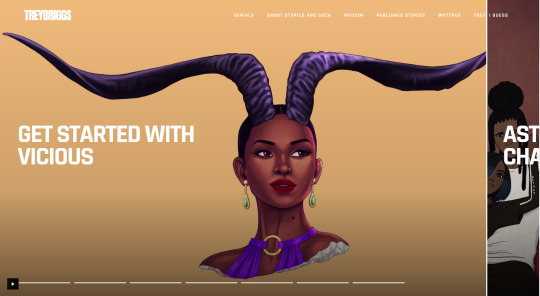
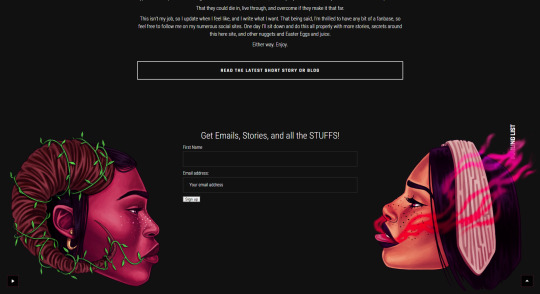
My stories are aimed at black people who want to read dark stories that focus on original black characters that are complex and interesting. I genuinely believe Black audiences deserve a variety of genres to delve into, and I want to introduce them to paranormal horror, dark romance, and fantasy that they haven't gotten enough of in the past. I also believe that this can be done across multiple mediums, and I spend my money with black creative professionals to make these experiences extend beyond my words. For the last two years, I've run my stories on sites and Instagram to great reception. I like to craft complex experiences that offer looks at character backgrounds, side and backstories, full websites for each title, and more. I also provide encyclopedias, maps, audio journals, and other ways to get into each world. During these last few years, I've run into a lot of walls, jumped a lot of hurdles, and tried my best. I've worked with amazing black artists, voice actors, and actresses, musicians, designers, and more. I trust my ability to run a project, especially when it comes to planning and finding talent. My overall goal is to run a team of black creatives that crafts novels, graphic novels, audio experiences, and animated series for a dedicated audience.
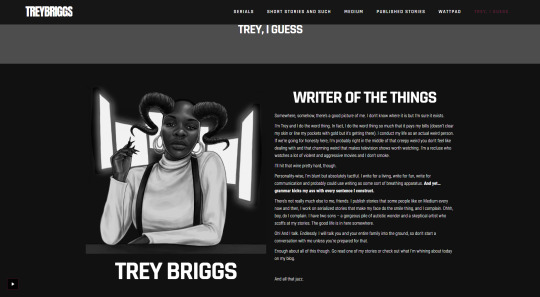
Why I Need Help Long story short: I have the skill, I have the marketing/website building/business experience, and I have the drive. There's a lot I can do on my own, but there's also a lot that gets left behind because I don't have the money I need to proceed at a steady pace. I need help with funding so I can focus, hire the right people, and craft these stories the way they deserve to be crafted. I have thus far spent over $60,000 of my own money on my projects over the past two years - the writing and site-building are easy for me; the rest has to be hired out. I have art, site costs for hosting, domains, templates, specific plugins, and maintenance, audio (and vocal artists to pay), musical, and editing costs. I'm by no means rich or even particularly financially stable. I have taken on tons of extra clients for my digital marketing business, transcribed hundreds of hours of audio for dirt cheap, and taken out personal loans. I even worked a second full-time job along with my full-time business last year to afford to produce the content I love. It's starting to take a toll on my mental health. I plan on continuing to fund these projects out of pocket (and finding ways to do so), but having financial help, however big or small, would allow me to move a lot faster and with less stress. It would let me flesh out ideas and concepts that I have had to scrap because I can only physically handle so much extra work. I run a full-time marketing business from home, homeschool my autistic 10-year-old, and generally have a busy life. Some of the strain is taking a toll on me, and I don't want to give up. Having some financial backing could allow me to drop a client or two after a few months and focus on the work I love to do.
How You Can Help I mainly need a start—a sort of base. I want to emphasize that I plan to continue to provide the main bulk of funding for my projects. I know my goals are ambitious, and I know each step will take time and money. I welcome any help to make the process smoother and to get around the initial hurdles. I'd like to have ebooks and novels offered on my site by the end of the year (along with the free serials and stories). Funding means that I can broaden the projects, include more free aspects to my sites, and secure direct financing through sales of ebooks and audiobooks sooner. It also means that I can offer MORE stories, whether they are online only or fully fleshed out novels and sites. I am swamped with trying to work enough to cover all my bills and creative projects, so I lose a lot of time I could spend plotting and writing. If I have better funding, I can get my stories out quicker (and with fewer mistakes).
The Initial Stories Let's talk about my stories! If you're familiar with my work already, you can skip to the next section. My main story site is Maybe Trey . Currently, I have two big titles and a bunch of smaller ones that I am seeking help with funding: Astrid the Devil
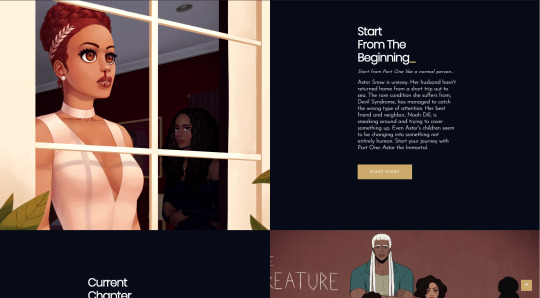
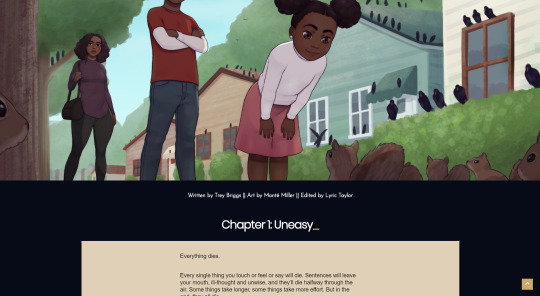
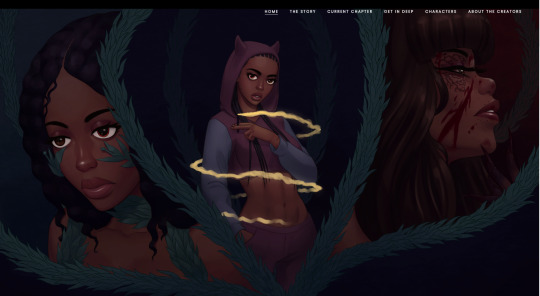

Astrid the Devil is the complicated story of a girl who inherits not only her family's features and DNA, but their fears, struggles, and fights. It's the story of a condition called Devil Syndrome, the women who suffer it, and the monsters that devour them. It's the story of the fight to save the people you love at the expense of innocent lives. At its core, Astrid the Devil is the story of a woman who inherits the chaos of three generations before her. It's a look at what is truly passed down to our children, and how they're left to fight our battles in the aftermath of our failures. It's the tale of an indescribable monster and the women who struggle to defeat it. It's a journey into how their every decision could save or destroy an entire world. Astrid the Devil is the story of Astrid Snow, but her story can't be told without the story of the women before her.
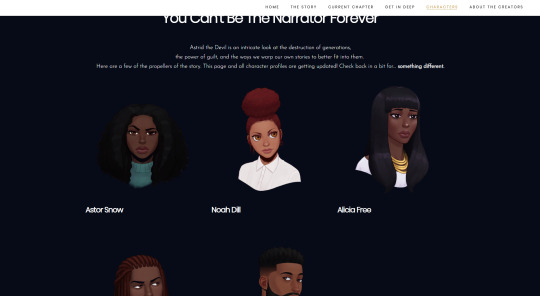
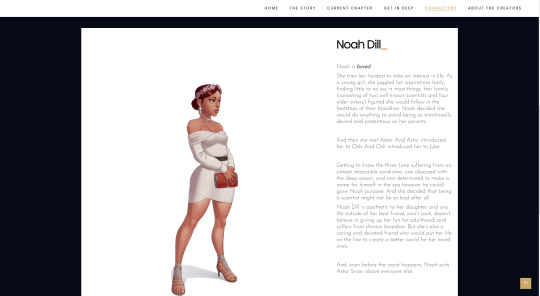
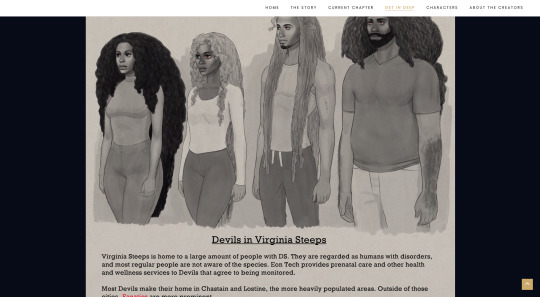
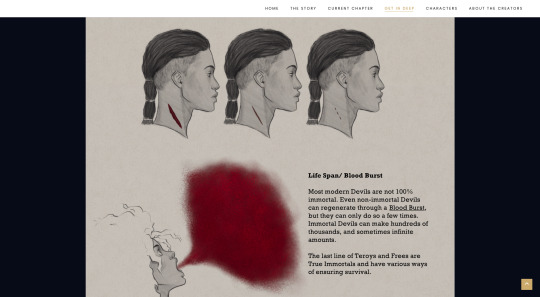
Vicious: On MaybeTrey and The Vicious site (in progress)
Somewhere, a war is brewing. That's the only thing that's for sure to Junnie Gorton, a young horned girl suffering from a debilitating disease called Horn Rot. She typically dealt with her low survival rate and abnormally large horns by escaping the world with her best friend, Lewish. Now she's forced to figure out which side is which, save her entire species, and find out the truth behind the sudden uprising in her home. Horn Rot, a highly contagious and violent disease spreading through horned people, is causing mass amounts of madness and death. Normal horns grow in ways that will pierce, suffocate, and maim their owners, and the only one who can stop it is Junnie's mother, Lyria. As Lyria falls deeper and deeper into an anti-social revolt, the country reels. While Junnie broods, her entire species must prepare for mass extinction. Her brother plots with a group of people with less than good intentions and Lewish is quieter than usual. In a civilization brought up on extreme violence and competition, Junnie and Lewish try their best not to get swallowed by their culture, their lives, or their horns.
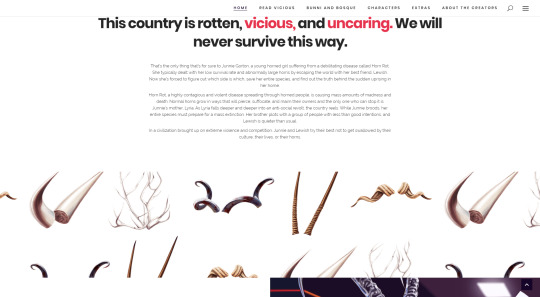
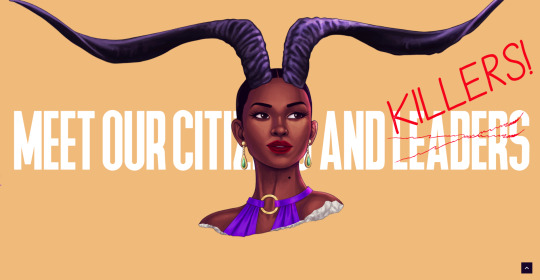
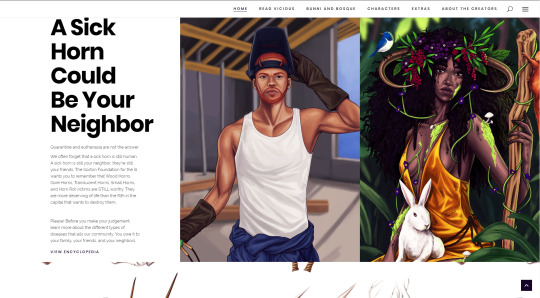
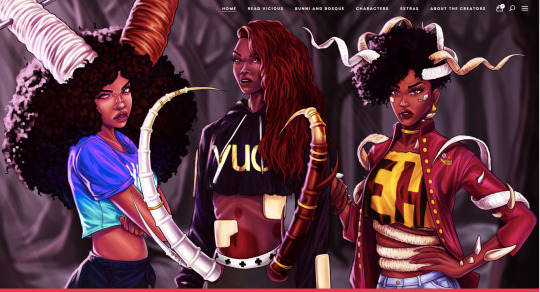
Bunni and Bosque :
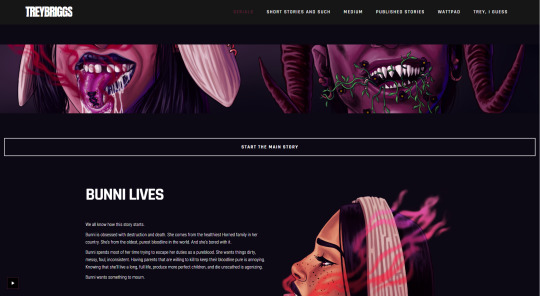
Bunni lives. Bosque dies. We all know how this story starts. Bunni is obsessed with destruction and death. She comes from the healthiest Horned family in her country. She's from the oldest, purest bloodline in the world. And she's bored with it. Bunni spends most of her time trying to escape her duties as a pureblood. She wants things dirty, messy, foul, inconsistent. Having parents that are willing to kill to keep their bloodline pure is annoying. Knowing that she'll live a long, full life, produce more perfect children, and die unscathed is agonizing. Bunni wants something to mourn. We all know how this story ends. Bosque is destined to die an agonizing death, alone on his family's land. He's watched everyone he loved and grew up with perish. Sometimes it was because of their disease. Sometimes it was because of the malice and hatred of others. While he's absolutely withdrawn and satisfied with his life, Bosque has never had a chance to live it. He spends his days basking in the sun, bathing in wood baths, and contemplating the end. Bosque isn't interested in joining the rest of the world. He'd rather die out, alone, where his family belonged. Bosque wants to go peacefully. But neither expected to meet each other one day in a supermarket. Neither expected to fall in love, lust, and every vicious and dirty thing between. Neither expected to be so right for each other, all while being wrong for everyone else. You know the end of this story. Bunni lives, Bosque dies. But maybe something will change.
My smaller titles, Bunni and Bosque /Aite and Jude, can be found at Maybe Trey .
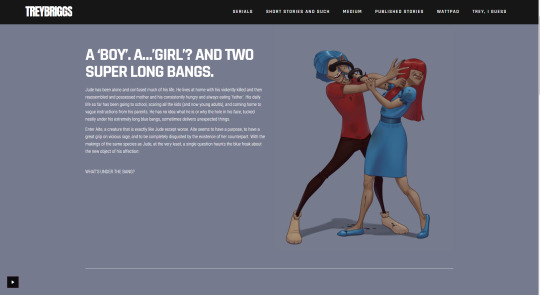
The Business Plan
The initial phase of my business plan is to get the sites populated with ebooks and audiobooks for sale. I also have prints that can be sold. Right now, I am in the audience-building phase while I save up for editing the full novels.
In terms of an actual business with which to publish the stories, I already have a registered publication company in Illinois: Wolfless Studios LLC. I took this step earlier this year with plans to self-publish Astrid and Vicious. So that is paid for and done.
I have also gotten initial editing done on the first six chapters of Astrid, though it will need to be edited from the beginning again once everything is said and done. I've spent over $1000 on that so far, and it would go a lot faster if I didn't need to save up to edit each chapter.
Astrid the Devil is fully plotted, outlined, and only needs the last three chapters. Bunni and Bosque and Vicious are newer, but plotted and already deep into character development (all being shared across social and Wattpad for audience growth). Aite and Jude and other shorts are plotted, and three other unshared stories are plotted and at the editing phase.
Other costs and ways I would use the funding (I would still put in my own money and do as much on my own as possible):
Initial $30K
$6000 - $7000 Line and Copy edits for Astrid (currently at 250000+ words/expecting over 300000 at $0.02 rate)
$6000 - $7000 Line and Copy Edits for Vicious
$3000 - $4000 Line and Copy Edits for Bunni and Bosque
ISBN Purchases (Separate ISBN for each format for each book) - https://www.myidentifiers.com/identify-protect-your-book/barcode
Covers for Astrid/Vicious/B&B Print Versions
Site Hosting Costs and Maintenance for 2 Years
Site completion for all stories
Initial store and app development
40K - Marketing and Graphic Novels
Social, Print, and Web ads
Email Marketing Campaigns
Booths at Decatur Book Festival (depending on COVID)
Social ads and promos
50 to 60 pages
First two chapters offered as free promo with email sign-ups
Audio journals for each character
Situational audio journals
Encyclopedia for Astrid (finishing up)/Vicious
65K - Hires and Next Phases
Ability to hire a Full-Time Editor
Audio Series for each (professionally done)
Vicious Graphic Novel
Additional Title Added
Short animations for both Vicious and Astrid (with plans to fund more with book sales)
Fleshed out Story Sections (Novellas for each character of each series)
Short comic series with Astrid and Vicious side characters
Possible to plan out monthly subscription service with new stories and 'story package' deliveries
75K -
Astrid the Devil Graphic Novel
Vicious Graphic Novel
Astrid the Devil Animated Short
Ability to hire part-time Web Developer
Additional bigger title
Anything Over - I ascend into pure light. And also, I can add titles, cover more mediums, and eventually expand my publishing to other black creatives.
From there, I should be able to handle the funding via sales of books, comics, audio, and more. Again, I will always offer mostly free content across the sites.
I believe in proof of concept, and I have diehard fans on my social platforms. With no outside funding, I've been able to a lot on my own. I'd love to expand my business into one that does the same for other black authors, artists, voice actors, and animators somewhere down the line.
Thank you so much for your consideration. I appreciate all my readers, present and future, and I appreciate any help!
See incentives and more on the actual campaign: https://www.gofundme.com/f/help-trey-publish-black-paranormal-horror-stories
Thank you so much!
#support black authors#writeblr#support black creators#black creators#original characters#original story#donate#buy black#black businesses#my writing#Astrid the Devil#Vicious#Bunni and Bosque#Aite and Jude#Trey Briggs the Writer#paranormal horror#speculative fiction#gofundme
3K notes
·
View notes
Note
Yooo, for the writer asks: 1, 21, and 23? :O
Evening darling, thank you for the asks! ^_^
Answering asks 1, 21, and 23 from this ask list.
1. Is there a story you’re holding off on writing for some reason?
Yes, actually! Right now I'm holding off on completing my Stolen Stories.
In the previous ask I mentioned that I completed the first draft of Book One in my Stolen Stories series between May and October of 2020.
My plan was to continue with that series and write Book Two while doing the first round of edits on Book One, so that I'd be writing Book Three while sending Book One out to Alpha/Beta readers. There's a full 6 books planned for that series, so I wanted to overlap them all slightly, and then eventually publish Book One sort of around the time I started writing Book 4.
But...
When I started looking into the publishing side of actually being a self published author, the reality of the process kind of hit me a little harder than I expected.
The first time you do something, anything, you're bound to make mistakes. I only have to look back at my first story to know that and, for all my years of writing practice, I've never hit the publish button on a book.
And 'Stolen' is my baby, for lack of a better term. Stella Korazon and Reilly Mosswolf are the darlings of my heart. I'd die for them, I'd kill or them. I do not want to "practice" the art of publishing a book with their story.
So Stolen, and it's sequels are currently on hold, and that's why I'm working on the Fey Touched novels right now. That's not to say I love Lizzy and Andric and Booker any less, but I have to split my mind into author and self-publisher. As an author, I love Fey Touched just as much as Stolen, but as a self-publisher a trilogy of 90k books failing is better than a 6-book series where each book is 140k+ failing.
Fey Touched is where I will hit publish for the first time and, hopefully, discover all the mistakes I'll inevitably make so that I can more effectively promote and market Stolen, when that monster of a series is ready for the world at large.
21. What do you think when you read over your older work?
That entirely depends on how old the work is :D
If it's something I've written within the last 1-5 years, then most of the time my reaction is something along the lines of;
"Oh wow, that's pretty good."
"Damn, that's an evocative line. Did I actually write this?"
"I FORGOT ABOUT THAT PART!!"
If, on the other hand, it's something like my first manuscript from when I was age 8 or 9, my reaction is usually something closer to;
"Oh no... that's... oh dear."
"Oh gods, please tell me I didn't say that..."
"Umm... That word doesn't mean what I thought it meant..."
"Bloody hell, I'm glad no one else will ever read this."
Having said that, @faelanvance takes great delight in digging through my old manuscripts and reading them back to me aloud for my ultimate mortification :D
23. Any obscure life experiences that you feel have helped your writing?
Probably too many to fit into a single tumblr post, honestly.
I'm constantly drawing from my own life experiences to put my readers into my characters positions. I can take pain and terror or Joy and Laughter from one set of experiences and then Copy/Paste it, for lack of a better term, into a different situation, but that direct knowledge lets me bring the descriptions to life for the reader. At least, I certainly hope it does!
As for specific situations that I feel have helped my writing... Let me just pick a couple.
(A) My Terrible Health
I mentioned in the previous ask that I was born with congenital talipes. Anyone can google it if they want more information, but it's also known as club foot. As a child, all this really meant to me was that I was constantly in and out of hospitals for operations and physiotherapy and that I wasn't physically able to run, jump, climb trees, or even walk long distances without my feet and legs hurting.
Also, because of the operations I spent a great deal of time in bed, or sitting in wheelchairs, while I recovered.
None of this is said in a negative light, in fact, in terms of my writing I'm rather grateful for all that free time to sit and think and imagine. I was and am a voracious reader. I was reading Tolkien's Lord of the Rings, and David Eddings' The Belgariad by myself at the age of 7 and 8. If I was only going to be allowed one book in hospital, I was going to make sure it was the longest book I could lay my grubby little hands on.
I could lay for hours on the children's ward while other patients yelled and fought over the single playstation or the jigsaw puzzles, and I could create entire worlds in my head. I could bring to life characters that could explore Middle Earth or go on adventures with Belgarath, and I only needed myself and my mind.
Books were a popular gift for me, because I was physically restricted, and then once I began picking up a pen, notebooks, journals, and fancy pens were quick to follow.
I think I would still have found writing, I can't imagine what my life would be like if I hadn't discovered this passion, but I'm not 100% sure I'd have discovered it as early as I did if I'd not been forced to stay still for so much of my childhood.
(B)
Another specific scenario that I feel really helped my confidence in my writing was my High School English teacher, Mr Reck.
I was bullied through most of my schooling, mostly for being on crutches, but this really didn't bother me. I just ignored them.
But one day we had been given a task in class, and I'd already finished, so as I usually did I pulled out my notebook and started writing a story while I waited or the next task.
One of the students thought to get me into trouble by telling Mr Reck that I wasn't doing the work. He came over, looked at my completed work, looked at what I was actually doing (writing an original story), and then told me that if I ever wanted someone to read over my writing and check it, I could always leave it on his desk during lunch... and then he calmly walked away.
This was, for 14-15 year old me, mind blowing.
I didn't care about the bullies, they really didn't bother me. I also wasn't self conscious about my writing, both my parents are and have always been strong supporters of my creative work. The reason this stood out to me at the time, and continues to stand out to me as one of the defining moments of my high school life was because it was the first time someone outside of my immediate family not only read my work, but thought it was good enough to actively encourage.
Mr Reck also got me into a writing workshop that year, that was only supposed to be available to graduating students. I've no idea how he managed it, but he did and I'll be forever grateful to him. I intend to add his name to the dedication page of the first book I publish, and I'm in the process right now of trying to track him down to send him a copy.
I think I've found him, I've just got to get the nerve up to send a private message to confirm!
If there are any teachers out there reading this though, please take note of this final story. I don't know that some teachers realise just how important one, single, non-family member showing a genuine interest in a students work can affect that students entire life.
4 notes
·
View notes
Text
Creative Problem Solving Methods Interviews
Name: AM
Industry: Associate Branded Content Editor at Who What Wear (4 years of experience in the digital media industry)
Summary:
As an editor, it’s AM’s job to keep an eye out for the latest fashion and media trends. Almost all of her writing is done for specific fashion clients so she usually has to take their direction and transform that in a way that meets their criteria and echoes WWW voice.
It’s so important for her to know what's popular to the WWW audience so she often gets inspired by her very own readers. “Instagram is such a huge hub for inspiration because there is such a huge variety of people, shoppers, and readers all in one app. My coworkers also inspire my writing and point of view so much. They’re seasoned writers with such compelling approaches to storytelling so I always look to their pieces as sources of inspiration.”
2) What obstacles do you face in coming up with a new idea and how do you overcome those obstacles?
This is typically a seasonal issue that she faces as an editor, but oftentimes clients will ask for stories surrounding the same exact theme which puts her in a creative rut. For example, a major theme this fall has been denim and she has had to write eight stories about denim while making them all sound completely different to avoid contradiction within her writing or competition on the Who What Wear website. When this happens, she turns to the branded content team for advice because a second or third perspective is always helpful when brainstorming. She also reads other publications to get an idea of what is being talked about in the industry at the moment. She says it could even be as simple as scrolling on Instagram and reading the comments on major denim brands to find that one distinguishing factor. “Usually, these techniques work well either alone or all together when overcoming a creative rut like the one I mentioned!”
3) What process(es) do you use to solve problems? (Describe the steps of your problem-solving process. Explain your journey from inspiration to implementation)
Problem-solving is an important part of her role as an editor because there are several teams and shared responsibilities that allow one single story to be published on the website. She’ll receive a request from the client services team to create headlines for a story focused on particular products or themes. Once a headline is approved by the client, she has full control of how the story looks and sounds. “I read the latest articles on the site to get my creative juices flowing and then I build out the story including priority products and key phrases. Because I’m not in direct communication with the client, it takes a bit longer for me to receive approval or links which can affect the intended timeline. When I can sense this happening, I turn to a coworker for assistance.” If they cannot help, she then takes it upon herself to make adjustments to the schedule. She makes sure she communicates with everyone involved to make sure that she’s not creating more problems as she attempts to solve the current ones. “Whether I’m in the inspiration or implementation phase, I truly value collaboration. Of course, I can solve problems on my own but I find that my solutions are more effective when I can get the experts involved.”
Name: JB
Industry: Business Consultant at Protiviti
Summary:
1) How do you generate ideas? How, when, and where are you inspired? What inspires you?
JB generates ideas in several ways depending on the situation. She believes the primary mediums that inspire her or help her in creating a solution to a problem are through her network, research, and spiritual methods such as praying and journaling. She described even simple issues such as finding an outfit she will draw inspiration from others such as Pinterest. Professionally, she believes her process is the same way concerning her project-based assignments in which collaboration from her network/team is crucial.
2) What obstacles do you face in coming up with a new idea and how do you overcome those obstacles?
The obstacles she faces would be fear in sharing new ideas and thinking it may not be good enough. In her role, it requires a lot of brainstorming and ideation in order to improve business processes for international clients. Questions that sometimes rack her mind are is this idea already taken, is it innovative enough, will it be feasible to implement in the given time frame. Also, timing and a lack of resources are impending obstacles in her day-to-day operations. In order to overcome these obstacles, she believes in stepping back and taking a break while also asking for help.
3) What process(es) do you use to solve problems? (Describe the steps of your problem-solving process. Explain your journey from inspiration to implementation)
Lastly, JB described her process as such:
Awareness of Problem
Assess
Identify the audience
Brainstorming/Information Gathering
Research
Design Thinking
Prioritize
Simplify simplify
Plan of action
Feedback
Repeat
Name: KD
Industry: Freelance Designer, Curator, and Musician
Summary:
1) How do you generate ideas? How, when, and where are you inspired? What inspires you?
KD draws inspiration through sensory experience such as her daydreams, touch, and thoughts in her head. Through actively engaging herself in these day to day sensual activities she grows more in tune with the art she feels led to bring to life. For example artists such as Beyoncé and Lauryn Hill show her the power of storytelling and how the effective use of art, music, design and talent can create something magical. By studying the artists she loves, she is constantly learning and leaving inspired. She also finds herself inspired when she steps outside of her comfort zone and delves into differing stylistic expressions. This process helps her push back her normal creative parameters and issues her to create something fresh and new each time but still staying true to unique style and self.
2) What obstacles do you face in coming up with a new idea and how do you overcome those obstacles?
Personal: when designing she gets caught up in the technicalities. Her desired vision is not coming to life on the screen.
Difficulty 2: classification naming in her industry. Harder to access and figure out where go
Team-Based:
Working with others when normally she has to work on her own, it sometimes gets hard trying to ensure the different designs and aesthetics can come together to create something even better than what the team tmshined. Hard to fuse the differ viewpoints
She has learned to overcome them by reaching out to her network in the design field. She finds this most helpful and helps her quicker than google would.
3) What process(es) do you use to solve problems? (Describe the steps of your problem-solving process. Explain your journey from inspiration to implementation)
Personal: KD first begins to write it down and talk through it as she is a visual processer. She tends to have so many concepts / ideas and never wants to forget so she writes every detail no matter how minute it may seem. Next, she steps away from the actual problem or idea right at the beginning and then she assessed what her prior idea was and now has a better perspective to tweak it. A fresh mind.
Key Takeaways & Final Thoughts:
After speaking with JB, AM, and KD about their processes, collaboration and teamwork are a huge factor in their success. I was interested in how JD incorporates a lot of design thinking and how frequently she has to work with others in her workspace. In my work, I spend a lot of time individually solving problems, which has led me to not really interact with others. Some of the things that stood out to me were AM’s processes and verbiage she used during the interview. Although we work in similar industries she focuses more on copy and editing while I focus on design construction and design concepts. It was cool to see how we connected but also the parts that differentiate us. KD’s rices was pretty interesting because she immediately steps away from the problem as soon as she writes an idea down. She would rather step away in the very beginning then come back and grind. I found it cool because normally people step away once they are stuck, age steps way right before she gets stuck. All three rely on sensual experiences, but some rely on spirituality/intrinsic motivations vs research/ public opinion. All these conversations were valuable as it gave me insight on the secret sauce that has helped my friends be successful in their careers and learn how to tweak my own problem solving processes.
1 note
·
View note
Text
What I think Biotech freshmen should learn during your first year at IU

So my first year has finally ended. The curriculum for freshman year is pre-determined by the Office of Academics so I did not have a chance to change the schedule. I took about 7 subjects each semester, with a total of 2 semesters. If you do not have to take IE1 and IE2 classes, you can “jump” directly into the main curriculum. So in my first year I took: Calculus 1&2, Physics 1&2, General Biology and Chemistry plus 2 Bio and Chem labs, Organic Chemistry, Academic English 1&2 (Reading, Writing, Speaking, Listening), Critical Thinking, Introduction to Biotechnology, P.E. It’s a relief that I could work through the courses although I was not excelling at STEM subjects in highschool. But college taught me all the amazing skills to study on my own and discover knowledge for my self-growth. Apart from schoolwork, I think any Biotech freshmen should also keep an eye on learning other extra skills of a scientist/professional, which I will list below. Do not worry because a year ago I entered this school while being a completely blank state, having seen so many of my friends succeeded in getting scholarships, leading extracurricular activities,... I felt hopeless sometimes but I believe in grinding one step at a time until I could accomplish the job. So my general experience boils down to being humble and let others teach you the skills, then practice slowly but firmly. You will be able to grow so much faster. And do not compare yourself with others’ success stories because everyone has their strengths and their own clock.
These are the lists of skills I have learnt and will continue to improve in the future. I will be expanding and giving more details about each point. This is in no chronological order:
- Learn to make a positive affirmations/ orienting articles book:
During your whole college career, you will have a lot of moments of self-doubt, for example when your grades are not good, you've failed some classes, your part-time job application got turned down too many times (trust me I am so familiar with such rejections), some experiments got messy and returned no results, you wonder what your future in the field would look like. These are all scenarios that have happened to me in freshman year.
Therefore, I have found a way to cope with self-doubt and boost my confidence, which is to make a collection of positive affirmations and orienting articles. I would form an imagined overview of my own career path reading all these writings and finally came to recording my own path . I use all forms of note-jotting tools to record them. I tend to record 1) Experience snippets from influencing scientists in my field, whom I happen to follow on Facebook 2) Lists of “What college kids need to practice before they graduate” (Dr.Le Tham Duong 's Facebook) 3) Ybox 's Shared tips for career orientation column (Link) 4) Short paragraphs from the books that I have read. The paragraphs often contain insights into what successful people (in Biotech or in Finance) have thought, have planned, and have acted on. For digital copy of the books, I save the snippets into a file called "Clippings" and later export them through the website called clippings.io
- Have an online note-taking tools for jotting down important thinking (recommend Keep or Evernote for quick jot, while Onenote is more suitable for recording lectures thanks to its structure that resembles a binder)
A snippet of my Evernote, where I store career advice:
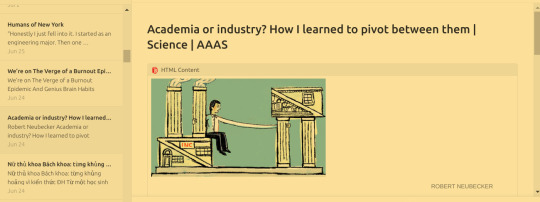
- Learn to do research properly (what is a journal, what is a citation management software, what is the structure of a paper[abstract, introduction, methods, data analysis, discussion, conclusion], poster, conferences). You can begin to search for academic papers using Google Scholar scholar.google.com. However, there are countless of other websites for published journals that serve different sience fields. You need to dig into Google further to find them.

- Learn to write essays (basic tasks are covered in Writing AE courses including brainstorming, reading, citings, argumentative essay, process essay, preparing thesis statement)
- Join a lab: learn the safety guidelines, learn who is in control of the lab, what researches/projects are being carried there). As for this, you need to make contact with professors from our department. Most professors here are friendly and willing to help if you just come up and ask a question after class. To be eligible to join their labs, - Learn to write a proper email to a professor: to ask for what will be on the next test, whether you can be a volunteer in their lab (usually by cold-email, and the professor will likely ask for your background: your highschool grades, your motivation,...); write email to an employer asking for a temporary position. - Learn to write a meeting minute: a sum-up of your meeting with other team members - Learn to answer basic questions for a volunteer opportunity: what is your strength, what is your past experience, what do you know about us, what is your free-time - Learn to write a CV: using topcv,... or downloading free templates on the Internet and write a motivation letter: What you are currently doing, what problems have you solved for your employers, and what can you do to help your new employers solve their problems.
- Learn to create an attractive presentation by using Canvas and learn to deliver ideas effectively (recommended book Think on your feet [Lib 1]).
I have discovered Canvas only for a year, but its graphics are so attractive and appealing to my taste, so here is my presentation for Finals using Canvas:
- Learn a programming language or a second language: recommend Python or R, and any foreign language that you feel interested in, but your ultimate goal would be to comfortably use that language in academic reading and exchanging ideas through writing and speaking (which is a long journey of 4+ years learning), so choose wisely. - Learn to create an online presence through a blog (Tumblr, Wordpress, Github, StackExchange,...), stalk your favorite experts on Quora and Reddit, make a habit to have a journal article delivered to your inbox every morning (me being Medium, Pocket, Nature); then Instagram or YouTube - Recommended books for incomming freshmen: How to be a straight-A student, Do not eat alone (socializing skills) - Recommended Medium sites: - Recommended Newspapers: The Economist, The Guardian, The New York Times Opinions Columns, Nature’s columns, The Scientific American. - Recommended Youtube Channels: - Recommended Podcasts: listen passively on the bus, but try to paraphrase in your own words what you have understood about their conversation: - Recommended study spots: Den Da Coffeeshop, The Coffeehouse, Library of [...] in District 1, Central Library (Thu Duc District), IU Library.
- Learn the Pomodoro technique and Forest app: - Important websites for study resources: libgen, khanacademy, Coursehero (post only a short paragraph to get 1 free upload), scripd organic chemistry tutor, for jobs: ybox.vn - If your laptop is capable (with decent hardware), learn Adobe Tools (Video editing, Photoshop,...). My laptop can only run Linux Mint, so I chose to learn the skill of citation management and research (using less resource). Basically do not become computer-illiterate. - To reduce eye-strain, buy an e-reader to read scientific papers, do not print out all of them. - One exception to IU: you can bring one two-sided A4 paper into certain exams: this is my note for Calculus class:
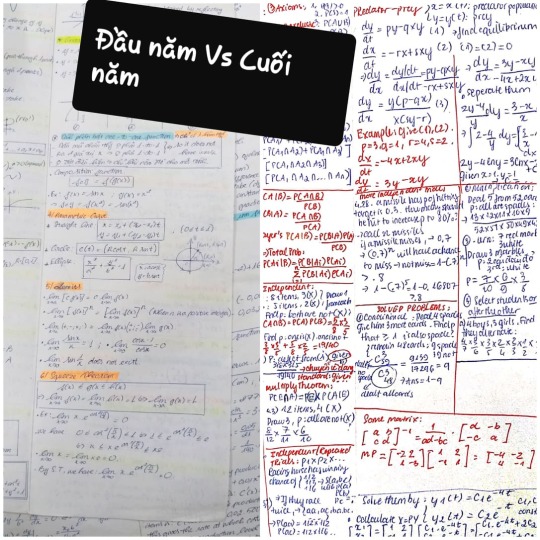
- Learn to write a grand summary of formulas for Physics 2, meta-sum of all exercise questions - Prepare for IELTS (if you haven't taken IELTS already): you'll need it to pass IE classes, or apply for an exchange program. Ultimately, you need at least 6.0 in IELTS to graduate. I stumbled upon this careful list of tips from a senior student in our BT department who got an 8.0 => Link
Basically, follow Ngoc Bach’s page on Facebook to receive fully-solved exam materials, add ielts-simon.com into the mix, learn 560 academic word list, listen to Ted Talk and podcasts, do tests on ieltsonlinetests.com, do Cambridge IELTS book 9-14 and you’re good to go. - Have your eyes on competitions that spark your interest (innovative competition, writing contests, speaking and debating contests,...)
- Develop your fitness routine to protect your sanity when academic coursework overwhelm you and make you gain 15 pounds.
I do home HIIT exercises on Fitness Blender’s Youtube channel, Emi Wong, Chloe Ting home workouts in the beginning.
Later I went to the gym and do split routines with weights, then threw in squats, deadlifts, lunges and HIIT on treadmill. This is how my current routine look like: (I work out only 4 times/week)
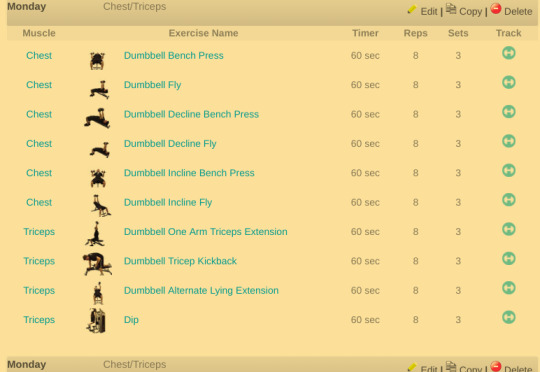
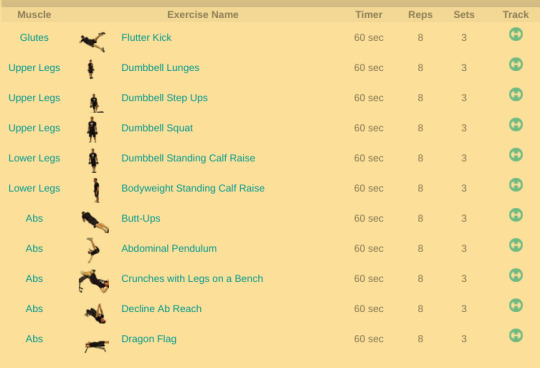
- Learn to use flashcards. (Quizlet has premade flashcards for biology class)
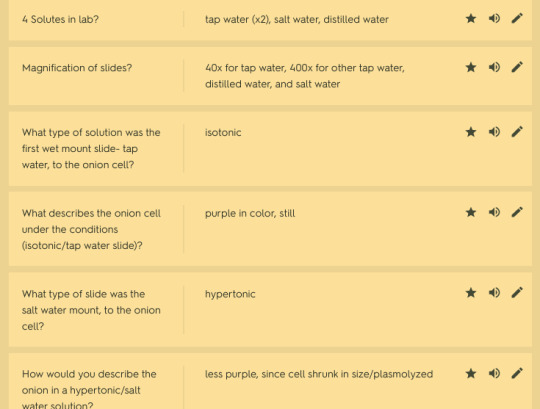
- Learn to manage personal finance: what is budget, expenses, income,... - Learn some google tweaks to pirate stuff. (especially textbook files and solutions files) - Learn to make handwritten A4 notes. I will post my own handwritten notes for Critical Thinking Mid (final is taken), Calculus II Mid and Final. - Learn to create meta sets for formulas and problems. I will post my formula set for Physics II and Problem/Skill set for Organic Chemistry. For Physics II, I learned my hard lesson is that it is better to do past exams than to solve advance textbook problems, so I stuck with past exams posted by TA and learnt by heart all the formulas, SI units. For Organic Chemistry you need a skillset checklist (like in the Wade textbook). Also there are questions from the slides such as the connection of amylopectin,... But they won't challenge you to think much. Only the amount of information to be memorized is deemed challenging here. - Intro to Biotech was quite easy and you could prepare in advance. 3 faculty members (from 3 fields: plant, animal, pharma) will take turn giving you an overview lecture. The exam will ask “Write what you know about those fields and their applications”, openbook-style. So hear me out and search for Overview powerpoints of that field, then write your own essay, print it out and bring it with you into the exam. Your power should be spent on Calculus and Physics, not on memorizing the essay.
6 notes
·
View notes
Text
[Qsc_asuw] Week 6 Newsletter
Welcome to Week Six! <3 We hope you have stayed safe and warm these past few days and continue to enjoy the days to come. REMINDER THAT THERE IS NO SCHOOL TOMORROW DUE TO CONTINUED DANGEROUS CONDITIONS, PLEASE STAY SAFE, take care of yourselves and each other. We hope you might find time to spend warmly with friends and community this week and engage in some necessary self-care. QTBIPOC Artist Spotlight of the Week: Amir Khadar Amir Khadar is a Non-binary West African multidisciplinary artist, whose main mediums are poetry, fibers, and digital art. For them, art is a space to rationalize their feelings as a marginalized individual, resist oppressive structures, and ultimately facilitate healing. Afrofuturism, black beauty, bitterness, hair, and spirituality are running themes in their work. Currently, Amir is a Sophomore at the Maryland Institute College of Art, where they are pursuing a B.F.A in Fibers and Humanistic studies.
The Queer & Trans People of Color Alliance (QTPOCA) will be meeting this Friday (Location TBD!)
REMINDER: Disability is an Asset: An Evening with Haben Girma this Wednesday, February 13th has been canceled and will be rescheduled.
Liberated Love: Growing a Healing Practice:
(Thursday, February 14) 6 PM - 8 PM @ The Rainier Arts Center
3515 S Alaska St, Seattle, WA 98118-1633
Experiencing hate is nothing new for us as LGBTQ+ people, particularly those of us LGBTQ folks that are also people of color. While national and local numbers of hate violence incidents’ are rising, we have known this hate to be true long before the numbers began to catch up. One of the most powerful ways we continue to resist hate and survive throughout the violence is by coming together; growing and sustaining deep, celebratory, and liberated communities rooted in love. Existing in community can be difficult though if we forget to tend to ourselves as well. Join the Northwest Network to learn and practice self-healing techniques. We hope for these techniques to serve as groundwork to engage and be fully present in communities, relationships, and families, of liberated love.
* More information about workshops and facilitators will be posted soon! Thank you for your patience.
This event is open to LGBTQ+ folks and their loved ones who have been affected by hate and hate violence.
ACCESSIBILITY INFORMATION:
Getting Here: The Rainier Arts Center is a 5-minute walk from the Columbia City Light Rail Station. Bus routes 7, 50, and 9 also stop within a block of the Rainier Arts Center.
The event space is the lower level of the Rainier Arts Building. The entrance for the space is on the northeast corner of the building. At the main entrance, there are both stairs and a ramp which lead into the basement of the building. The space has both ADA accessible and all gender restrooms. *Feel free to reach out with any other accessibility questions.
Winter Quarter Social Justice Film Series
(Wednesday, February 13, 2019) 6:30 PM
The Kelly ECC is back with another social justice film series for winter quarter!
Each Wednesday evening at 6:30, we'll be screening a film in the main lobby! We hope to see you there!
February's Focus: Black History Month
March's Focus: Women's History Month
------
FILM LINE-UP:
• February 13: American Promise
• February 20: The African Americans: Many Rivers to Cross
• February 27: Dark Girls
• March 6: Ladies First
• March 13: Neerja
ACCESSIBILITY INFORMATION:
The Samuel E. Kelly Ethnic Cultural Center is near landmarks such as Alder Hall and Lander Hall.
For a map, search HUB on the campus maps: www.washington.edu/maps
The ECC’s front entrance is wheelchair accessible. There is an elevator in the building.
There are universal, all-gender bathrooms in the building, as well as gender binary bathrooms with multiple stalls.
The ECC is not kept scent-free, but we ask that you do not wear scented/fragranced products (e.g. perfume, hair products) or essential oils to/in the event in order to make the space accessible to those with chemical injury or multiple chemical sensitivity.
University District Metro Bus Routes can be found here:
metro.kingcounty.gov/tops/bus/neighborhoods/university_district.html
A Certain Type of Brilliance
(Thursday, February 14, 2019) 7 PM - 9 PM @
Gay City: Seattle's LGBTQ Center
517 E Pike St, Seattle, Washington 98122
Femmes possess an alchemy that can’t be quantified, but which draws us together and enables us to be bold, ingenious, and capable of a magic that fortifies our own hearts and the soul of the community around us. A Certain Type of Brilliance is a celebration of femmes’ ability to pull amazing things out of thin air, to create on a dime, to use our vulnerability and creativity as our greatest assets in resistance to oppression.
The production features a unique cast each night; performers will create a new piece of work in the 24 hours prior to the show in response to one of a series of prompts, drawing on themes of resistance, resilience, femme identity & power.
Other Dates Offered:
FRIDAY FEB. 15 (7:00 PM - 9:00 PM)
SATURDAY FEB. 16 (7:00 PM - 9:00 PM)
SUNDAY FEB. 17 (7:00 PM - 9:00 PM)
ACCESSIBILITY INFORMATION:
https://www.gaycity.org/accessibility/
All restrooms are gender-neutral.
Smoking & Fragrances are prohibited on Gay City premises. Do not wear scented/fragranced products (e.g. perfume, hair products) or essential oils to/in the event in order to make the space accessible to those with chemical injury or multiple chemical sensitivity.
All spaces, doors, and corridors are at least 32 inches wide and ADA compliant.
All doors in the building open manually.
There are two steps from the auditorium/library hallway to Kaladi Bros Coffee and to go to the restrooms. In order to go between the coffee shop/restrooms and the auditorium/library without using any steps, you will need to go outside and enter through the other external door.
Playfulness as Resistance! 25th Anniversary Party
(Saturday, February 16, 2019) 7 PM - 11 PM @ Jacob Lawrence Gallery
University of Washington Art Building 1915 Chelan Lane Seattle, WA 98195
Tickets: $15 General admission/$5 students
With DJ sets by:
SassyBlack
Felisha Ledesma (S1 Portland)
dos leches + Eve Defy (TUF Collective, Seattle)
Dive into a ball pit by Colleen Louise Barry, sip a cocktail crafted by our celebrity bartender Timothy Rysdyke, get a copy of the brand new MONDAY (Vol. 3), dance under an installation by Disco Nap, snack on a donut from General Porpoise, and leave wearing a temporary tattoo by Claire Cowie!
FOOD + DRINK + FUN!
ACCESSIBILITY INFORMATION:
The gallery is wheelchair accessible.
The Gallery is smoking-free but not kept scent-free, we ask that you do not wear scented/fragranced products (e.g. perfume, hair products) or essential oils to/in the event in order to make the space accessible to those with chemical injury or multiple chemical sensitivity.
There are no dogs allowed in the gallery.
Generifus • Flying Fish Cove • Izumi
(Wednesday, February 20, 2019) 7:30 PM - 10:30 PM @
Timbre Room
1809 Minor Avenue #10, Seattle, Washington 98101
$8 • Doors at 7:30 • Music begins at 8pm sharp
Generifus •
Intricate and magnificent legendary rock pop from Olympia, WA
https://generifus.bandcamp.com
Flying Fish Cove •
Mythical melodies and dreamy moods, and they bop
Izumi •
Modern folk that is pure heart and magic spun into song
https://izumi.bandcamp.com
How The Body Hold's It's Stories
(Thursday, February 28, 2019) 7 PM - 9 PM
Hugo House
1634 11th Ave, Seattle, Washington 98122
How do our bodies hold onto experiences? How do generations of people of color, queer and trans people, and others who have experienced marginalization carry those stories over generations? Join writers Jordan Alam and Tessa Zeng for a reading and conversation on feeling a story in your bones and translating it to the page. Musician Lex Gavin will also perform. ABOUT THE PERFORMERS: Jordan Alam is a queer Bangladeshi-American writer, performer, and social change educator based out of Seattle. Her work engages with moments of rupture and transformation in the lives of people on the margins. Jordan’s work is heavily engaged in community, and she is a current Kundiman Pacific Northwest co-chair and 4Culture Artist Grant recipient. Her short stories and articles have appeared in The Atlantic, CultureStrike Magazine, The Rumpus, and AAWW’s The Margins; she has spoken at events including the Aspen Ideas Festival and the Eyes on Bangladesh exhibition. She is also the founder of the Asian American social justice publication, Project As [I] Am (http://www.project-as-i-am.com). Most recently, she has completed a fellowship with Town Hall Seattle to create collaborative performance pieces about stories of the body and been editing a draft of her debut novel. Lex Gavin is a multidisciplinary artist living in Seattle. Their brain (and thus their work) grapples with paradox, perception, nuance, and the failures of identity. They are interested in magic, neuroscience/somatics/epigenetics, and human systems. When they are not neglecting their creative pursuits, they work in the youth development field and play in the kitchen. Tessa Zeng is a writer, systems change advocate, and co-creative maker. She has been published in various poetry anthologies and journals, and received an Individualized BA from Goddard College for her work on social misrecognition. With their work, they hope to create beautiful experiences of interconnection and recognition that can heal traumas caused by oppressive structures.
ACCESSIBILITY INFORMATION:
The new Hugo House is fully ADA-compliant. If you require specific accommodations, please contact us so that we may assist you.
There are gender-neutral bathrooms.
Public transportation: The new Hugo House is a short walk from the Capitol Hill light rail station and the First Hill streetcar (Broadway & Pike-Pine stop) and within a half-mile of many buses, including routes 8, 10, 11, 43, 49, and 60.
Parking: A pay parking lot is available nearby at the Greek Orthodox Church at 13th and Howell, or at Seattle Central College’s Harvard Garage at 1609 Harvard Avenue. Street parking is also available but not guaranteed. The garage beneath Hugo House is for tenants only.
Free, rapid HIV Testing and PrEP counseling provided by Lifelong.
First come, first serve, walk-in appointments available on the last Monday of every month during Fall, Winter, and Spring quarters!
Other Times Offered (All times at Q-Center from 1:00 PM - 4:00 PM) :
Monday, February 25th
Monday, March 25
Monday, April 29
Monday, May 27
ACCESSIBILITY INFORMATION:
The Husky Union Building is near landmarks such as Allen Library, Padelford and Sieg. For a map, search HUB on the campus maps: http://www.washington.edu/maps/.The HUB’s front entrance is wheelchair accessible and the common area is to the right of the main desk.
An all-genders restroom can be found at the 3rd floor, down the hallway from the Q Center. Gender binary bathrooms with multiple stalls can be found on each floor of the HUB.
The HUB IS not kept scent-free but we ask that you do not wear scented/fragranced products (e.g. perfume, hair products) or essential oils to/in the Q Center in order to make the space accessible to those with chemical injury or multiple chemical sensitivity. To request disability accommodation, contact the Disability Services Office at 206-543-6450 (voice), 206-543-6452 (TTY), 206-685-7264 (fax), or [email protected] 10 days in advance.
Let’s Talk is a free program that connects UW students with support from experienced counselors from the Counseling Center and Hall Health Center without an appointment. Counselors hold drop-in hours at four sites on campus:
Mondays, 2-4 PM, Odegaard Library Room 222
Tuesdays, 2-4 PM, Ethnic Cultural Center Room 306
Wednesdays, 2-4 PM, Q Center (HUB 315)
Thursdays, 2-4 PM, Mary Gates Hall Room 134E
Let’s Talk offers informal consultation – it is not a substitute for regular therapy, counseling, or psychiatric care. To learn more, visit
letstalk.washington.edu.
ACCESSIBILITY INFORMATION:
The HUB’s front entrance is wheelchair accessible and the common area is to the right of the main desk.
An all-genders restroom can be found at the 3rd floor, down the hallway from the Q Center. Gender binary bathrooms with multiple stalls can be found on each floor of the HUB.
The HUB IS not kept scent-free but we ask that you do not wear scented/fragranced products (e.g. perfume, hair products) or essential oils to/in the Q Center in order to make the space accessible to those with chemical injury or multiple chemical sensitivity.
The ECC has single-stall gender-neutral bathrooms on each floor, near the gender-binary bathrooms to which signs are indicated.
Odegaard Library is not ADA accessible nor scent free.
All rooms in Mary Gates Hall are wheelchair accessible. Please contact the Disability Services Office at 206.543.6450 or [email protected]. MGH is not scent free.
Thank you for being a part of our community <3 We are so glad that you are here, and we are so glad to get to know you! Have questions about the QSC? Just want to get involved? Find our office hours online at hours.asuw.org. To hear more from the QSC be sure to like us on facebook, and follow us on twitter & instagram to stay up to date with all queer and trans related happenings on campus and in Seattle! With love, Mehria Ibrahimi, Outreach & Engagement Intern.
1 note
·
View note
Text
apa style tips
karui-ame replied to your post “I’ve gotten so used to writing academic essays that I end up writing...”
Hey, any good tips or resources for APA! I only learned MLA in high school and need to expand.
Oof I’ve been doing it for so long it’s a little bit more habit now than anything, but sure I can list some stuff!
Some resources:
Citation Machine is a site good for citing in the various formats, but they also have guidelines for them too. Unfortunately it’s gotten very revenue focused recently, but the information on the site is still good!
If you have Microsoft Word, there’s a formatted APA style template you can use that provides the pages/text/formatting needed and you just type into it.
PurdueOwl is always a good go to reference as they have the most up to date resources (I believe APA is currently in its 6th edition?)
GOOGLE SCHOLAR WILL SAVE YOUR LIFE. Look on the right side of the page for links. Those will most often have the full text without a paywall.
On some publishing house sites, they’ll already have the option for you to cite the article in APA.
On chrome I have the extension Super Simple Highlighter which lets me highlight text on sites. So when I’m scrolling through an 88pg pdf file and trying to remember choice quotes, this highlighter saves my damn life. It also gathers everything on a nice little window so I can reference it all the easier.



Tips & Tricks:
When in doubt, cite. Cite cite cite. If you say there’s 2 million people in one of the major American metropolis cities, you need a reference. You can’t claim anything without referencing it, even if it’s common knowledge. Because psychology is a field heavily dependent on outside sources and studies, you have to give credit where it’s due, otherwise you’re plagiarizing. (It’s a pain in the ass, I know.)
In-text citations are fairly similar to MLA, though with APA all you need is the last name and year, for example: (LastName, 2018). The parenthesis go before the period. If you’re quoting someone, and Allen Walker said “I’ll keep walking,” (Walker, 2018). is how it’d go with quote marks before the parenthesis AND the period.
APA is one of the most pedantic styles imo. If you have a long name and want to use initials, such as electroconvulsive therapy, you have to specify it. Electroconvulsive therapy (ECT), etc.
APA is double-spaced, 12pt font, Times New Roman. I recommend writing in an un-formatted document and then changing it, since it helps to meet word counts (I recently wrote a 12 pg essay with about.... 16 references used in the end. Working on a blank document and copy pasting saved the dread of meeting that page count...)
Save every single link, book, site, video, etc you look at and cite them all at the end. As you’re writing however, cite as you go, even if its just a placeholder (ect & bilateral experiment), because forgetting to properly cite will land you in hot water. APA takes plagiarism extremely seriously (given how hard these journals are to write, I don’t really blame them).
“Article” and “Journal” are the same thing in psychology.
Journals often have a lot of heavy text and terms and the sad thing is there’s no alternative. You really have to read it all very carefully.
I’m sure there are some things I’m forgetting, but I hope this helps! If you have more questions feel free to ask ^^��
17 notes
·
View notes
Text
The Eastern Front, A Wargamer’s Retrospective
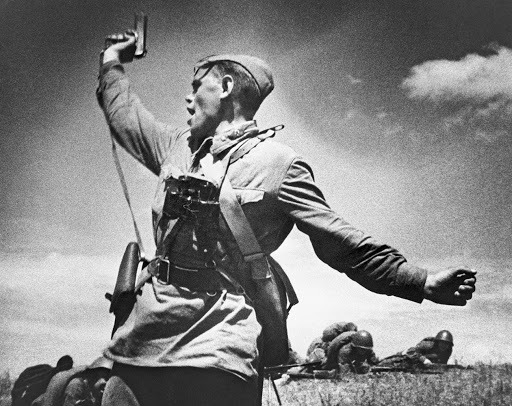
A Soviet Officer leads his troops forward, 1942 | Russia Beyond
A little over 80 years ago, 3.8 million Axis military personnel crashed across the Soviet frontier in a bid to succeed where Napoleon failed. The aim of Operation Barbarossa was simple: crush the Soviet Union by the first snows. Fortunately, this failed and resulted in a titanic struggle along a 1,800-mile front for four years. It only truly ended when the Soviet army raised the red flag over the shattered shell of the Reichstag on May 2nd, 1945. During the conflict, the Soviets lost 27 million people, military and civilian. It was a war without pause or pity on either side as two dictators fought it out in some of the most monumental battles the world has seen. Places like Dubno, Kharkiv, Kursk, Stalingrad, and Berlin have become synonymous with some of the worst fighting of the Second World War.
But as much as the Eastern Front encompassed a pitiless crescendo of violence that also played an unfortunate center stage to atrocity and death, it’s also a hell of a tableau for wargamers who are into World War II. Is there a bit of a moral quandary? There is, and I’d be foolish not to acknowledge it, but I will also say this. The moral thing to do in such cases is to acknowledge it happened and be aware of it in your gaming. Don’t glorify it and honor the victims. But at the same time, don’t be afraid to game it. We can’t learn from history unless we’re willing to work with it, clear-eyed and knowledgeable. I am of Russian-Jewish extraction myself, and yes, I have quite of bit of Eastern Front wargaming paraphernalia.
With that, I have some Eastern Front board games and computer games I recommend. Are they the ENTIRE Eastern front experience? Nope. Like many of the major engagements of the Second World War, the Eastern front has spawned a lot of books and wargames.
Board and Computer Wargames
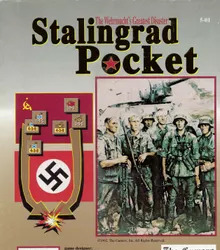
Board Game Geek
I played the heck out of this game in my twenties, and when I found a copy cheap at a hobby shop auction, I snapped it up like a penguin does mackerel. It’s got all the joys of a Standard Combat Series (SCS) game, and while I admit the 2nd edition is better, I happen to have a weakness for the 1st edition myself. Call it nostalgia. It reflects the limits of the Soviets in 1942 (they had some issues advancing as far and as fast as they did when they launched Operation Uranus) and a competent German player can do a lot better than Von Paulus did. The SCS is awesome as it comes with a standard set of rules that bridges all the games in the series and then game-specific rules to cover special case stuff unique to a game in the series. I own quite a few SCS games, and they’re my favorite MMP titles. The rules are solid, make sense, and play fast.
The best part, the 1st edition is cheap to come by. 2nd edition, not so much. I do wish MMP would reprint this, but they did do Storm Over Stalingrad, so perhaps I should give this a try. It’s a bit more like the old Avalon Hill Turning Point: Stalingrad.
As for a VASSAL module, it’s only available for 2nd edition, but at least it’s available.
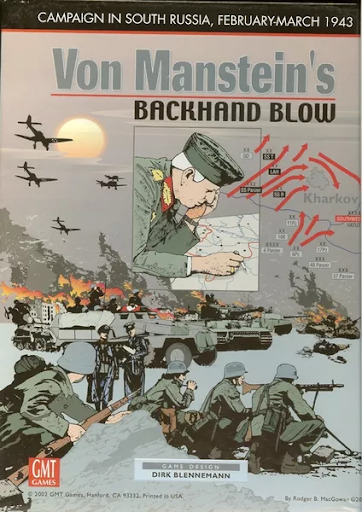
Board Game Geek
This one is as tense a game as I have ever played. I mean, this one does come down to the last turn. GMT has a masterpiece in Backhand Blow. It’s easy to play and very hard to master, especially as the Germans are operating on a knife’s edge for most of the conflict. I love the 3CI points system. It really does a good job of limiting your options while reflecting the difficulties both sides had coordinating the actual battle in 1943. I really do love this game, and I lucked out finding it at a Congress of Gamers event a few years ago for a real steal.
The best part is the game is available for some pretty reasonable prices on Board Game Geek and has a VASSAL module.
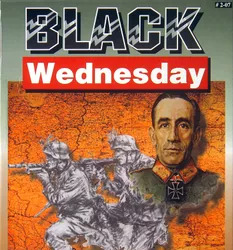
Board Game Geek
I am not usually someone to trumpet the Tactical Combat Series (TCS). While I like the detail and gameplay, I am not nuts about the order system. You practically have to write an operations order before you begin play. Yeah, I know there are people out there who love that sort of thing. Hey, whatever floats your boat. I do like the fact that the orders you write are often invalidated by circumstance, and you must improvise like real commanders.
I rather like MMPs approach to series rules, though, and it works well here. Plus, in my “Jason likes gonzo subjects” column, the game is centered around one of the most vicious battles involving the Spanish “Blue Division.” As casualties mounted for the Germans in the east, they tried to internationalize the war as a “crusade against communism.” To varying degrees, it worked, and many volunteer legions joined the Wehrmacht and Waffen-SS. To be honest, and feel free to correct me, this is the first wargame I’ve seen with these guys.
I’ve played the game once, and it is a tough slog for both sides. Both sides have good troops, and it’s in marshy terrain near Lake Ladoga, so it’s a real close-range barn burner. It took a friend and me a week to finish it, but it was one of those wargaming journeys that made it worth it. The game does an exceptionally good job of reflecting German and Soviet doctrines. If you want a playable monster game about a little-known action on the Eastern front, find this one.
Sadly it’s a bit hard to find on Board Game Geek, but when you find it, you can get it for a reasonable price. There’s also a VASSAL module, which will do a lot to make life easier.
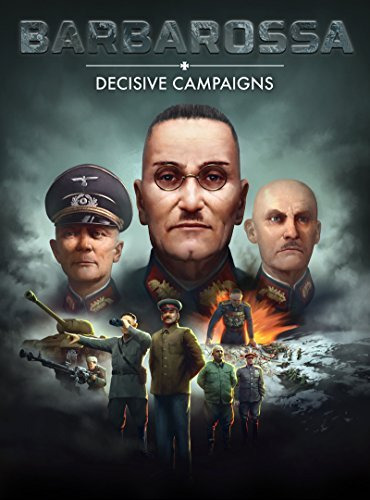
Amazon
Told you I’d slip a computer game in there! Slitherine put out in my mind one of the best operational games I’ve played in a while. It’s also one of the best computer games on Barbarossa, bar none. The game is fairly simple on its surface, with pretty cookie-cutter movement and attacks over a very nicely implemented map. The live combat results are a nice touch. What makes this game special is the ability to work with your subordinates and superiors. Every decision you make is going to make someone happy …and tick someone else off. This is especially so for the Germans, who have a ton of competing personalities. You also have to pay attention to logistics, and woe be the commander who ignores things like rail infrastructure and captured Soviet trucks!
The Soviet AI is good, makes you fight, and does a better job of avoiding encirclements than the real Soviet army did in 1941. I haven’t actually played the Soviets yet, but I’ve been told by other players that your main worry is not to screw up too badly that Stalin shoots you.
I really can’t say enough nice things about this game. I keep coming back to play it again and again, and to me, that’s the mark of a good computer game. If you don’t have it? I’d get it. It doesn’t need a high-end PC to run, and it does a lot in a very capable package. It’s currently available on Steam for $16.49, which is a real steal for this game.
Conclusion
The Eastern front is a huge tableau to wargame on, with titanic battles that have written their name across history. There really is something for everyone here. I do hope this article has been an inspiration for you to dip your toes into this tableau. As always, Good Gaming, Everyone.
At Epoch XP, we specialize in creating compelling narratives and provide research to give your game the kind of details that engage your players and create a resonant world they want to spend time in. If you are interested in learning more about our gaming research services, you can browse Epoch XP's service on our parent site, SJR Research.
--
(This article is credited to Jason Weiser. Jason is a long-time wargamer with published works in the Journal of the Society of Twentieth Century Wargamers; Miniature Wargames Magazine; and Wargames, Strategy, and Soldier.)
0 notes
Text
Stories of Our Lives - Epilogue
Disclaimer: All publicly recognizable characters and settings are the property of their respective owners. The original characters and plot are the property of the author. No money is being made from this work. No copyright infringement is intended.
May 21, 2043 - 23 years later
She stared out into the spacious backyard. It was littered with young adults, aging parents and laughter, lots of laughter. It was a joyous occasion they were celebrating but her parents and family members tend to take celebrating a little too serious. They didn’t need an excuse to throw a party but this time they had a great one.
Cora and her brother had just graduated from university - her with a journalism degree, him with a degree in engineering. She had landed a coveted spot at a magazine that was very vested in her father’s career back in the day; Oli and a friend had launched a new engineering firm in the heart of London, focusing on energy and resource consulting and a lot of other stuff she didn’t understand. He loved it though and that was the most important thing.
“Why are you in here and not out there?” She was pushed from her thoughts as the question came from her mother.
She smiled, pushing her brunette hair from her face before sighing. “It’s mayhem out there. That’s why Oli is out there and I’m here.”
“They’re family, love. They’re not going to attack you.” Gia smiled at her oldest daughter.
Cora lifted an eyebrow in her mother’s direction, something she learned from her father. “I don’t know about that. We haven’t had a full family get together in quite a while. I mean, Harry hasn’t reached his hugging quota for the day yet.”
“Be nice Cordelia Ann or I’ll stick your father on you.” Gia warned pointing a finger in her daughter’s direction.
Cora rolled her eyes. “Daddy will back me up on that one.”
Her father and her were often found in cahoots with one another, driving her mother absolutely nuts. It was just one of the many special things she shared with her daddy. “I don’t doubt he will.”
Cora looked at her mother with worried eyes. “Are you alright mum?”
“I am . . . just can’t believe I’m old enough to have children graduate from university.” Gia wiped her eyes. “I’m so proud of you and your brother.”
She pulled her mum into a hug, melting into the feeling of being in her mum’s arms. “I’m not going anywhere. I’ve got an office in London and you’ll still see me for family dinners. I’m just moving into a new house and starting a job. I’m still your little girl, no matter what.”
“I know, it’s just that you’re so grown up and it’s difficult for your old mum to handle.” Gia laughed, pulling back from the hug.
Cora smiled at her mum. “No matter what you’ll always be my mum. That will never change. I love you mummy.”
“I love you too bug. What’s this special surprise you’re teasing us about?” Gia grinned at her daughter, hoping she would spill the beans.
Cora laughed. “Nice try mum but you’re going to have to wait just like everyone else.”
The back door swung open interrupting the mother-daughter moment. “What’s going on in here?”
“Leave it Lou . . . just a little mother daughter bonding.” Gia swatted at her husband as he pulled both of his girls into his arms.
He looked at them both carefully before sighing. “If there are tears, I’m out of here.”
“You missed it by five minutes. You’re in the clear.” Gia teased, leaning up and kissing her husband. “Let’s go back to the party.”
Not giving the two a chance to speak, she scooted out the door leaving father and daughter in the kitchen. “She ok?”
“She can’t believe she's old enough to have kids graduating from uni. She’s just being sentimental.” Cora smiled at her father. There were times he was still clueless of what went on in the household, often turning to one of his daughters for an explanation.
Louis nodded, taking a drink from the beer he retrieved from the fridge. “I’m with her there. Seems like yesterday we were bringing you and Oli home from the hospital. And now look at us; you’re working at the magazine and Oli has his own business.”
“We’re still your children, dad. That’s not going to change; what will change is that we’re more successful than you currently are.”
Cora was out the door before it even registered with Louis what she said. “You little bugger; I’m going to get you.”
“Come on old man, we’ll fight right here, right now.” Cora loved challenging her father and was very good at it; Gia often times break up their playful fighting.
Gia gave her husband a look which translated to Louis as ‘knock it off’. “Maybe some other time. I’m going to go reminisce with your uncles about the good old days.”
One Direction had disbanded in 2032 after a worldwide tour. The boys, all with children by that point, wanted to have some normalcy and raise their children at home instead of the road. For their fortieth anniversary since forming on X-Factor, they did a mini reunion tour around the world, which quickly sold out surprising their children. Rolling Stones Magazine ran a special collector’s edition filled with interviews of the men and what they were up to. Cora had a hand in that and even sat down to interview the guys at their request.
Cora spent the afternoon catching up with her cousins; between the five men there were 15 children and the next generation of children was starting as well. The age range between the 15 was Mollie at 30 and Braelyn at 9 years old. With the wide range of ages, there was always someone to talk to and hang out with.
“Cora come on! Come play with us.” Her cousin Berto yelled kicking a football between his feet.
Looking at her clothing attire, she frowned. “I’m in a dress.”
“Hasn’t stopped you before Delia.” Oli grinned at his sister who simply kicked off her shoes before running barefoot into the group.
Dinner quickly broke up any games going on. As always, it was an affair with so many people rushing around. Once everyone was settled, Louis smiled at the group.
“Thank you for taking time out of your oh so busy schedules so you lot could come celebrate Cora and Oli’s graduation with us.” He smiled at his best friends, siblings, parents, children, and his wife surrounding him. “We are extremely proud of Oli and Cora and cannot wait to see what you two accomplish in the future. To Cora and Oli.”
“Cora and Oli.” Everyone echoed, before turning back to the food in front of them.
After dinner was cleared, a bonfire was quickly assembled, guitars bought from the house and a sing-a-long started. This was tradition no matter the house or occasion. A few One Direction songs were sung before moving onto modern music to appease the younger generation.
That generation soon lost interest, causing focus to shift to Cora. “So you mentioned you had a surprise for all of us. Spill chica, I can’t handle the suspense.”
“Way to put me on the spot, Mollie.” Cora stood up glaring at her oldest cousin.
Mollie grinned. “Well then you shouldn’t have opened your mouth. I’m surprise more people aren’t bugging you, namely the mums.”
“Mum already tried; I shot her down.” Cora grinned, escaping into the house quickly before returning. “So one of my final projects was write a paper on what is important to me.”
“What did you pick?” Niall asked looking at his nervous niece, something that wasn’t common.
Cora smiled looking around the crowded backyard at her family. “Crazy enough, I wrote about you guys, my family.”
“Hopefully you stuck with the positive stuff about us.” Harry yelled causing her to laugh loudly.
Cora grimaced, biting her lip. “Yeah I mean there’s some good things in there.”
Her comment caused the men of the group to protest, loudly, causing everyone else in the group to laugh. “What did you get on it?”
“It wasn’t graded; it was just the final piece of a semester long project.”
Harry grinned, watching Cora’s shift uncomfortable at the prospect of her family reading the piece. “So can we read it or are you going to tease us?”
“Yeah you can read it. I’ve got copies for each family - you get to fight for who reads it first.” Cora smirked handing out the papers to each of her uncles and father.
Louis smiled at her daughter, taking the paper from her. “You nervous?”
“More than when the article I did on you guys was published.” She admitted, biting her lip and looking at her dad.
He nodded, giving her a quick hug. “Well this is just another step in the process. Everyone here loves you and will say nothing but positive things about this piece. If they don’t, send them my way.”
The way he cracked his knuckles after the statement caused her to laugh. Soon all the papers were handed out, causing her to look anywhere but her family member’s faces. “I’m going inside, call me when you’re done.”
Louis shook his head at his daughter. She had always been this way; nervous about any feedback on anything, refusing to look in your direction until you were ready to give your opinion and anxious for anything negative.
Taking a seat, he grinned at Gia. “You ready to read this?”
“There’s nothing incriminating in there, Louis.” Gia shook her head. “I already know I’m going to love it. She’s an amazing writer and I’m glad the world has the chance to read her words.”
The Most Important Things - Cordelia Tomlinson
There are lots of things important to me - my friends, my life experiences, the job that I will be accepting in the upcoming days. But there has been one constant in my life that has always been there no matter what was going on.
For the past four years of uni, I have been taught that the written word holds so much power; you have the ability to make people laugh, cry, smile, question, recall memories and the power to surprise. Hopefully along these pages, there will be some surprises, some moments to cry or laugh, maybe some anger but hopefully a lot of good memories and smiling moments.
I have biological aunts and uncles, galore. Mum was one of five and dad was one of seven. I have lots of biological cousins. But that’s not what this paper is about.
I am one of the 15 kids that know what it was like to grow up in post heydays of One Direction. Most of my childhood, until the age of 12 was spent on a tour bus traveling around. Before I was two, my passport had more stamps on it than most businessmen. I spent my sixth birthday in New York City, ice skating in Rockefeller Plaza. I got the opportunity to do more things than other ordinary children - my classroom was a bus window; I got the hand on experiences that most adults could on dream about
And along the way had the most amazing family I could have ever asked for. This paper is about them.
Dad was the oldest member of One Direction, the single most successful band in the history of the X-Factor show. Him and three other guys were thrown together and the rest, they say is history. When he was put with those three other boys, he had met his three best friends to travel on this journey with.
Each boy brought something unique to the group and from there, anyone who was brought into the group added a missing element and unique touch to the group as a whole. The order I’ll talk about each of my ‘uncles’ is not meant to show favoritism (but let the record show, Uncle Niall is my favorite, sorry boys!) All of my uncles were favorites at one time or another but Niall remains my favoritest ever.
Speaking of Niall, we’ll start with him. He is the Irish one of the group; little blonde leprechaun. He can make you laugh no matter what kind of day you have. He’s just one of those people who is the life of the party and no matter what, is always ready for a pick up footie match, which is why I think he’s my favorite. Him and I have gone to lots of games over the years and a lot of my special times with him include food and footie. He’s married to Tricia, who is lovely and amazing (sidenote, my uncles knew how to pick incredible women to marry - they are all amazing and have put up with a lot of shit over the years). She’s a photographer, which means the camera is never far from her hands. She is just one of those laid back women, who you just want to curl up next to and spill your guts. She always had a habit of getting me to talk, even if I didn’t want to.
They have three kids. Mollie Ann is the oldest of the 18 kids. Her mum is Tricia but she’s from a previous relationship but you would never know it. Her and Niall are so much alike it’s not funny. She would often join mine and Niall’s footie trips due to her being the only child of his to actually have an interest in the sport, which automatically made her “daddy’s little girl.” She often goes by Walshy, though only certain people are allowed to call her that including my dad and Niall. She was actively involved in sports, particularly football, which caused the rest of us children to practically grow up on the pitch. Saturdays were spent on the golf course, alongside her father, despite her lack of enjoyment of the sport. As a child, everyone thought she would join her mum in the journalism field but surprised us all by becoming a lawyer, despite her sweet and gentle personality. It actually made sense though because she was tougher than she looked. Her law background came in handy, especially during arguments among cousins.
Patrick Frey is their second child. He is identically to his father, only difference is that Patrick is a natural blonde. Patrick is the one you go to if you have any trouble; the amount of people he knows is amazing and he’s always has the connection, no matter what you need. He was the rebellious one of the Horan family; him and his parents had a rocky relationship for about three years. His troublemaking ways led to an accident that got his younger brother in the hospital. This served as a wake-up call for Patrick, who changed his ways after that. Although he grew up to be a good son and brother, Niall still refers to him as their “handsome devil.” That’s not necessarily a bad thing, especially for someone who becomes London’s bad boy restaurateur. As an adult, Patrick bonds with his father over their shared love for food and beer (good thing he owns a handful of restaurants and bars)!
Their third is Robert Henley, and goes by “Berto or Bertie, but never Bert”, per Niall, the youngest Horan was named after his grandfather. With his dark hair and blue eyes, Berto could easily charm the pants off people like his older brother, if he weren’t ridiculously shy. At age 7, he broke an arm while on a walk with Patrick, who was ambushed by school bullies. Berto was quiet; he made good grades like his sister; he often stayed in his room doodling or playing video games. Niall nearly had a heart attack when he heard his then 19 year-old son sing and play the guitar for the first time. Berto is the only one of the 18 children to pursue a career in music.
Liam Payne is next. Liam is the uncle you go to when you need someone to tell you you’re being stupid or want a honest opinion. He is the most sensible of the group, but will always have your back no matter what stupid move you pulled. One of his strong points is embarrassing his own children along with his nieces and nephews without taking it too far. He is still in the music business; him and my dad opened up a production company after One Direction, where they both write and produce songs for up and coming artists. He’s married to Danielle, who is this incredible dancer and has her own studio. She used to dance with the likes of Justin Timberlake and Ellie Goulding among many, many more. She was the cool aunt that would take the older cousins backstage of the most popular tickets around London - in fact she was the one that introduced me to Justin Timberlake, much to the annoyance of my childhood friends.
This is where I say I feel so bad for Liam - him and Danielle got lucky with three children, all girls. He often escapes to Niall’s house just to escape the estrogen induced household he’s built for himself. Georgina Ava is their oldest and a dancer just like her mother. Danielle had each of the three girls in dance classes before they could walk. Georgie is a big ball of hyper - identical to her father. She has performed at the Brits and even gone on tour with big names. She is never home so when we do get together, it’s usually for dinner and drinks. She loves to dream and has always kept her eye on her dreams, something I admire about her. She is dating a fellow dancer named Adam and I think I hear wedding bells in the future (sorry uncle Liam! He is just not ready to let his baby girl go just yet).
Savannah Alexa Payne is the middle child; she’s a hip hop dancer who spends most of her time at her mum’s studio teaching classes. She has always been the center of the spotlight, demanding your attention to watch her spin and twirl. There are girls who love dance and then there’s Savannah who eats, breathes, and lives dance. More times than not, she has tried to teach me simple dances, but my two left feet get in the way and I end up pulling muscles or breaking bones (a broken growth plate is nothing to laugh about). She is dating the sweetest boy named Ryan, whose father is Olly Murs, much to Liam’s humor.
The baby of the family is Adelaide Hope who is still in school. She is 16 and just getting into the boy phase much to the horror of her father. (For the record, all of the guys had decided early on that their daughters would not officially date until they were 16 years old), though several girls, who shall not be named (coughMollieGeorginacough), gave their father’s a hard time about that rule. Addie is daddy’s little girl. She is the sports star within their family - though her mother tried to get her into dance. She’s the pitcher of her softball team and has a wicked throw - officially schooling the boys within the family. Addie is my little buddy; anytime she’s around my flat, we are watching sports with some kind of sweet dessert, usually ice cream or cupcakes from the bakery below my flat.
Harry Styles, the Greek God of One Direction (or so mum’s of my friends used to tell me - which by the way, no 12 year old ever wants to hear about her uncle!) Harry is typically around our house on any given time. He is always up for a laugh and would usually pop up at my internship at the magazine. He is a charmer, and is credited with teaching his son and the other boys within the family the fine art of flirting. He is hopelessly tied to Scarlett, who act like they’re dating more than being married. Scarlett is a Physical Therapist, which comes in handy when 7 of the 15 children are clumsy and are found most of the time in casts.
Amelia Dominique is the apple in her father’s eyes. She is a daddy’s girl through and through. All she has to do is bat those long eyelashes of hers and Harry is putty in her hands. Lia is a part-time model while she is going to school for acting lessons. She has starred in a couple of commercials, her parents being very strict with what she was allowed to pursue while keeping a normal school schedule. She is leaving in July to shoot her first feature movie which she is very excited for. Amelia is my go-to lazy day person. Her and I sit around in sweatpants, watching stupid television shows that no one else will watch with us.
Jackson Edward Styles was born legally deaf. Harry and Scarlett quickly learned signed language to help their young son navigate the strange world around him. The entire family learned, some of us more quickly than others. Jackson and I bonded rather quickly, both us very quick with our signing. He received cochlear implants when he was 4; I was in the room, at his request, when they were turned on and tears immediately flowed from my eyes when he recognized my voice. We have a special bond that doesn’t compare to anyone else in the family. To this day, Jackson is the one that can actually calm me down when I’m stressed beyond my pushing point.
Last but not least, is my actual family. Mum and dad are crazy; I’m just going to throw that out there. I’ll tell you about my siblings before circling back to my padres.
Oliver is the oldest; my twin brother. We are 12 minutes apart and he has held those twelve minutes over my head more times than I care to admit. He’s super smart and is an engineer - he just opened his own business that looks into energy sources (I don’t understand half of what he says but I still think it’s cool that he’s doing it). Oli is my go to person; despite the fact we’re twins, we’ve always been closed. He’s bailed me out more times and I’ve had to lie for him many more times. Mum and dad quickly learned they had to be a tag team when dealing with the two of us. Often times, both of us would be grounded at the same time because we would stick up for one another. Oliver is engaged (shocker!!!) to his best friend named Eleanor and they’re getting married in October.
We’ll skip me for now (don’t worry that’s the good part of the story!). This is where my family gets crazy. Maisie is 20; she knows what she wants and she goes after it. At twenty, she is a part owner of a local business. Since she was legal to do so, she’s been working at a bakery (the exact bakery that is below my flat). She is a tremendous baker. Her red velvet cupcakes are to die for. She’s always been in the kitchen, since she was little, helping mum bake and cook. She’s going to make someone a very happy husband when she decides to settle down. All I have to do is text her the word ‘hummingbird’ and she knows to make me a batch of my favorite cupcakes. It’s good to know a personal baker from time to time!
Asher is mum and dad’s little science geek. From the time he was little, he was always fascinated by blood, guts, and gore. Anytime any of us went to the hospital, he was always there asking the doctors questions and wanting to know everything about medicine; it's no surprise that he wants to be a pediatrician. At 18, he doesn’t know if he wants to stay in England for school or go abroad to the US. Mum has voiced her opinion on the matter but will support him in his decision, whenever he decides. My time with Asher is dinner and a movie; that’s about all the attention span he has for me, especially while his girlfriend is around. Asher is dating Amelia Styles; they are completely adorable and Harry has laid down the law more than once with Asher.
(So little side story, when mum and dad were first married, they agreed on three or four children; so you’d think they’d stick with that plan right? Nah not my parents. There’s two more little bundles of joy in the house, bringing the grand total to six children in the Tomlinson family. We joke that they should have had two more to beat Nana Jay but mum doesn’t think it’s that funny of a joke!)
Elodie is 13 and completely boy crazy much to the chagrin of dad. He kind of had it easy with me and Maisie but it’s biting him in the butt with Elodie. She has her eyes set on a couple of neighborhood boys, but daddy is keeping a tight leash on her until she’s 16 (he’s constantly citing that rule whenever Dee brings up the issues of boys). Other than boys, she is a major fan of music but doesn’t have any interest in pursuing a career in it. She plays guitar and drums, much to the excitement of Niall. She is more often than not found over at his house jamming the afternoon and nights away. Elodie is also my shopping buddy. She is opinionated and is not afraid to tell it like it is, which has gotten me in trouble many times.
And finally, we have Braelyn, mum and dad’s oopsy child - they thought they were done with Elodie but Brae was bound and determined to make her presence known. She was a preemie baby; she was born six weeks early, spending the first four weeks of her life in NICU. She was my little fighter and now is completely healthy, happy, and footie player. At nine years old, she’s the captain of her little team and is trying out for a traveling team. She’s mum and dad’s free spirited child as well. Ninety percent of the time she doesn’t know where she’s going but she’ll figure it out when she gets there. Her flightiness has gotten her into trouble one too many times. She is more often late for appointments, something her, mum, and dad are all trying to work on.
And that leaves, my mum and dad. Dad is one of my best friends. He’s usually the first one I call no matter what situation I find myself in. I’ve called him many times in the middle of the night when I’m pulling an all nighter just for a reminder that I’m alright and everything will be ok. I’ve been described as a daddy’s girl but there’s nothing wrong with that. The only thing we disagree with is our footie teams - dad’s Manchester United while I’m more of a Chelsea girl. He forgives me for that but still gives me hell about it. No matter what’s going on, he always has time for us kids; when we were little, him and mum always took us out for one on one time so we could talk about anything and everything.
Mum is strong in her own right. She has to put up with a lot of crap from dad’s fans despite being married to dad for the past 24 years. Before she became a stay at home mum, she was a bombardier for the British Army; she was the lead engineer for the bombers and had to opportunity to travel to war-torn countries. She was kidnapped twice while on duty, once while dating my dad. She officially retired when she became pregnant with me and Oli. I think that’s why Oli became an engineer was because of mum’s stories. Mum has always been there with a hug and a soothing voice when things got tough.
And me? I’m the one that always had her head in a book, pen to paper, and one who was shy, but that has been broken since being with the magazine. I loved traveling when I was younger and to this day, still love going places by train and plane instead of car. England will always be home but I love visiting the United States, Spain (especially Sevilla, a place significant to my parents’ relationship) and Africa. I have a puppy named Tipperary (after a region in Ireland that I fell in love with and is significant to my own relationship). I have been married for two years now - John was someone who came into my life and completely changed it. I hated him but we were forced to work on a project, and his charm and wit won me over.
So I’ve written 3900 words and the question was what’s the most important to me. Well, those relationships I have with 23+ individuals is what’s important. What’s a little more important are the lessons each of those people have taught me. Growing up in the spotlight is never easy but with each of those people by my side, I’ve conquered a lot of my fears and overcome them with their love, support, and words.
But my parents have always taught us to be true to who we are. And always keep those most important close to you.
So in closing, if I can be half the parent my parents have been to me, I think I’ll be alright in the end. And surprise, mum and dad, you’re going to be grandparents in November.
Cordelia Ann Thomas
Gia looked around the backyard, looking for Cora but failed to see her. Her husband squeezed her hand to gain her attention. “She’s in the house, should we go see her?”
A bright smile was stretched across Louis’ face and one was stretching across Gia’s face. “Can you believe it?”
“Well it was bound to happen sooner or later.” Louis smirked at his wife pulling her into a hug. “Grandparents, can you believe it?”
Gia laughed. “Nope but this day keeps getting better and better. So what’s the plan?”
“Act like we didn’t read that part . . . let her actually tell us instead of us reading it.” Louis smirked knowing it would irritate his daughter.
The two walked into the house to see Cora and John standing in the kitchen quietly talking. “Hey you two. Did you finish it?”
“We did and it was great darling. You are a fantastic writer. Your mum cried a couple of times.” Louis hugged his oldest daughter tightly.
Looking up at her dad, Cora smiled. “Anything surprise you?”
“Nah not really. You made me choke up when you were describing our relationship but I love you Delia. That might be my favorite thing you’ve ever written.” Louis kissed her cheek.
Gia stepped up and hugged her daughter tightly. “You’re a brilliant writer and I love it. That was one amazing piece for your final project.”
“Thanks mum. Anything surprise you?” Cora looked at John, turning her attention to her parents.
Gia shook her head. “Everything I knew but it was great reading it again. Your uncles got a laugh when they read what you wrote about them. And more than one of your aunts shed tears while reading their sections. That’s why you’re such a brilliant writer; you know how to play with your audience's’ emotions.”
She listened to her parents go on about how brilliant of a writer she is; usually she loves listening to feedback, especially from her parents but she had dropped a bombshell in that piece and she couldn’t believe her parents hadn’t picked it up.
“Ok stop.” She leaned against the counter and looked at her parents closely. “Are you two pulling my leg or something? Or is this like that hidden camera show you two love to watch?”
Louis and Gia traded glances, looking at Cora in confusion. “What are you talking about? We’re praising you for your work and you’re yelling at us?”
“Did you two not read the last line of the writing?” Cora took a deep breath, trying to calm down and not yell at her parents.
Louis smirked, loving watching his daughter squirm. “You mean about how if you can be half the parent we were to you, then you’ll be alright?”
“Yeah that line. Did you read the second part of that line?” Cora asked, John coming to stand beside her, his hand squeezing hers for reassurance.
Gia shook her head. “I must have missed it. I was just so excited to tell you what I thought about the book that I just assumed it was finished.”
“Well if you had read it, there was a surprise for you both in it.” Cora sighed, smiling brightly at her parents. “John and I are going to be parents in November.”
Louis and Gia’s jaws both dropped before Gia squealed. “What? You’re pregnant?”
“And you both are horrible actors.” John commented looking at his in-laws with a smirk on his face.
Cora looked between her husband and parents. “What did I just miss?”
“Your parents knew the entire time you are pregnant . . . I think they were pulling your leg, hun.” John said wrapping his arms around her in a hug.
She pouted, looking at her parents. “You two are mean. Why would you do that?”
“Never did I think I’d read that my oldest daughter is pregnant via her last piece as a college student.” Louis said reaching over and giving Cora a hug. “Your mum and I are thrilled for you two.”
Cora’s pout was replaced by a smile. “Thanks daddy. I thought it would be a cool way for you two to find out but I guess it backfired a bit.”
November 12, 2043
After 22 hours of labor, she finally got to hold her newborn in her arms. A tired smile was on her face as she looked at her parents. “You want to hold her?”
Gia nodded, immediately reaching for the baby. “Oh hi little one. Oh you’re so tiny.”
“You doing all right?” Louis looked at his daughter with a smile.
Cora glanced at John before nodding. “Yeah sore but happy, tired, and every other emotion in the world.”
“Have you decided on a name?” Gia looked between the two new parents before handing over her new granddaughter to her husband.
John shrugged looking at his wife. “We’ve got it narrowed down to two names but haven’t decided on one of them yet. I think the name Cora picked is perfect for her but she isn’t sure.”
“Can you tell us the two names?” Louis studied his granddaughter’s face before looking at his daughter and son-in-law.
Cora smirked. “The middle name is the same but the first name is different. Evelyn or Felicity.”
“Both are gorgeous names.” Gia murmured. “But I think I like Evelyn slight more than Felicity.”
Handing back the baby to her mummy, Louis smirked. “I think I like Evelyn better as well.”
John looked at his wife and smirked. “Well then I guess this little girl finally has her name. Nana, Papa, meet Evelyn Louisa Grant.”
“Louisa?” Louis looked at his daughter with tears pricking his eyes. “You named her after me?”
Cora nodded, smiling at her father. “You have been an incredible influence; I wanted our daughter to be named after someone who has had a massive impact on my life.”
Lightly hugging his daughter, Louis pressed his lips to her forehead. “You have given me an amazing gift, Cordelia. I love you.”
“Love you too old man.”
Throughout the years, Gia and Louis’ family would grow with more in-laws, grandchildren, and animals but the love they had for each other continued to grow as well. They both had lives fulfilled with cherished memories and amazing experiences.
0 notes
Text
Writers and readers meme
I got tagged by @dawnfelagund and @nimium-amatrix-ingenii-sui! Thank you! ^_^
1) How many works in progress do you currently have?
I have one original novel (I call it my Mexico book) it was a memoir/travel book at first. But I realized that I could tell more of the truth about my experiences if I presented it has fiction. OMG! Started it at least 13 or 14 years ago and work in it for a couple of days every year. I wish I could just plow through it and get it finished. I even had an agent for it once, but her mother got sick and she dumped me! That took away a lot my original impetus.
Fanfiction? I am scandalous about accumulating WIP. I haven’t abandoned any of those--some have a lot of work in them--like from over 20,000 words to 150,000 and those are the long ones. I have bunch in the 5,000-20,000-word range. I try to finish at least one of those on the back burner a year. Meanwhile, I write in the neighborhood of 30-100,000 finished pieces a year.
2) Do you/would you write fanfiction?
Really a lot and really a lot of fandom-related non-fiction. I have 715,511 words on AO3 (Oshun) and 106 fanfic stories (oshun) on the Silmarillion Writers Guild and 87 character biographies.
3) Do you prefer paper books or ebooks?
I’ve always loved the touch and weight of books! But now, due to vision problems, I can really only read ebooks for pleasure. Still occasionally use paper books for research, but it kills me. (Pet peeve online is a website and or a blog with pages that are illegible/unzoomable--automatic exclusion of me! So sad, but usually I get mad. I hate to feel left out.) Twenty years ago I would have been at this point in my degenerative state limited to audio books and unable to write at all without a private secretary! Yay, for technology!
4) When did you start writing?
I wrote a piece of fanfiction--a rip off of Edgar Allen Poe when I was about seven or eight. My big brother read it aloud to my whole family, laughing like a hyena! I wrote a fanfic play based on the first chapter of Little Women and staged it with my younger brother, sisters, and a cousin in our living room when I was 10 or 11 years old. The acting was terrible, but the costumes were great! (Beth was my chunky, red-cheeked cousin. I was scrambling to cast that part. She wasn’t pretty enough in my mean little heart to be Amy and my youngest sister was and had golden curls. Would you be surprised to discover I cast myself as Jo?)
5) Do you have someone you trust that you share your work with?
I have always had close fandom friends with whom I have shared by work before publishing, although I will do without a Beta if it becomes a nuisance to find one. (If you look at my stories, I always have given credit to anyone who has read my drafts.) Currently, @dawnfelagund occasionally reads my fiction drafts and goes over virtually all of my non-fiction. For over 12 years or so, @ignoblebard has probably Beta-read 90% of my fanfic. My two sisters closest in age to me read all of my non-fannish writing and my daughter reads a lot of it also.
6) Where is your favorite place to write?
On a desktop with a great big screen at my writing desk in my bedroom. (The vision problem again.)
7) Favorite childhood book?
OMG! There were so many! Little Women was one (actually everything by Louisa May Alcott), the Lamb’s Tales from Shakespeare (countless times), a bunch of Arthurian legend books (none of the really good ones were available to me), Pinrod and Sam by Booth Tarkington, and Ivanhoe by Sir Walter Scott, I was addicted to Jane Austen. I read a lot of history and historical fiction also (enough Anne Boleyn fiction to gag a maggot!). I started reading adult books at about 8 or 9. My parents did not censor books and the house was overflowing with everything from all of the classics to mysteries, everything but romance novels--actually those were forbidden.
8) Writing for fun or publication?
Both. Mostly for myself over the last ten years (ha! I called it teaching myself to write fiction!). Most of my adult life I’ve made a living doing some sort of writing or editing--everything from translating and writing for a wire service to working at newspapers to freelance journalism, to copy-checking for law firms.
9) Pen and paper or computer?
Computer. I hate to write by hand, although I have a good hand. But it’s double the work to type what one has written out of a legal pad or notebook. And now my eyes would kill me! (I do carry a tiny notebook for ideas or notes at a public event.)
10) Have you ever taken any writing classes?
I majored in English lit. We churned out papers back in my day like we were being paid by the page--copious amounts of copy and generally pretty thoroughly pulled to pieces by our professors. (It’s kind of made me a rebel. I get a huge kick out of breaking writing rules.) I was raised on Strunk and White, however, which I still consult when something worries me.
11) What inspires you to write?
People? Ruminating about what makes people tick? My fanfic, for example, is character-centered. I love to tear apart Tolkien’s characters and put them back together in a manner that is satisfying to me--human, emotional, flawed, likeable, complicated, funny, and sometimes ridiculous, while being tragic. Plotty stories can be OK, but I used to say that most of the action in my fics takes place inside of my characters�� heads. I also like examining political, cultural, and historical motivations in fanfiction. Setting is important to me also. And I can write a love story between two people that is packed with family interactions. (I came from a huge family.)
Who wants to be tagged?? I tag you people all the time and probably tag the wrong ones! Please answer these questions if you want and tag me so I can read your answers!
3 notes
·
View notes
Text
The Massage Therapists Survival Guide
New Post has been published on https://autotraffixpro.app/allenmendezsr/the-massage-therapists-survival-guide/
The Massage Therapists Survival Guide

Buy Now




Massage Therapists Survival Guide (ebook)
Published in 2010 – 64 pages
Do you want a long and enjoyable career in Massage Therapy?
Do you want your patients to get the most benefit possible from your treatment?
Do you want to reduce excessive stress on your own body by maximizing your efficiency?
Do you want to generate greater income by treating more patients?
Do you want to have greater work satisfaction by improving your results?
Do you want relief and better still, resolution from those painful fingers, wrists, shoulders, neck, and back?
My motivation for writing this ebook is to help you achieve all the above outcomes and for you to love this very important career.
Testimonials
Nice work. It seems to sum up some very important facts that you just don’t learn about in your ‘schooling years’. I think only years of clinical and top level treatment teams could pass this on!Soft Tissue Therapist James Barker Canberra
I have seen several books on this topic over the last 17 years, but none as comprehensive as this. Most useful summaries of treatment techniques for effective patient treatment and minimisation of undue stress upon the therapist.Of course your techniques work for me, as I have been using them since my first course with you around 14 years ago and I have been able to pass on your good advice to several other therapists over the years.Your book goes well beyond the purely mechanical aspects of caring for ourselves, as indeed we need to go beyond being just body mechanics by creating confidence in our patients by our whole approach to our learning and to individual patient care. Such aspects are also well addressed in your book.
Soft Tissue Therapist Graeme Mills Melbourne
Just read your e book …..Congratulations! I found chapter 3 regarding thoracic, elbow and scapula posture particularly helpful. I’m always fine tuning my treatment posture and it was great to have some clearly stated angles to stabilise the glenohumeral joint that I can now work with.You also nailed chapter 2 in outlining the importance of establishing a strong belief and value in your profession. This is the most important factor for me as I believe if you hold your profession in high regard the rest (ie. satisfaction, success, motivation) can only but follow.I could go on but there are too many little gems in the book to mention. I hope that this is the first of many more books, the way in which you write is really informative but also really inspiring, motivating and uplifting.
Myotherapist Moyan Phillips Melbourne
Who is the author Robert Granter?
Rob has an Advanced Diploma of Remedial Massage (Myotherapy) from RMIT University, Melbourne and has 23 years experience in Soft Tissue Therapy within the Australian Sports Medicine Multidisciplinary Model. Since 1992, he has delivered over 30 conference presentations within Australia, the UK, and New Zealand.
Rob was a contributor to the textbook Clinical Sports Medicine by Dr. P. Brukner and Dr. K. Khan, which is now in its 3rd revised edition and has sold over 40,000 copies worldwide. He is co-founder of the Australasian College of Soft Tissue Therapy and is the only Soft Tissue Therapist on the editorial board of the British Journal of Sports Medicine.
Rob is based in Melbourne, Australia, and has been head of Massage Therapy/Soft Tissue Therapy/Myotherapy for:
Australian Olympic teams for Atlanta 1996 and Sydney 2000
Victorian Institute of Sport (10 years)
2006 Commonwealth Games, Melbourne
The Sports Medicine Centres of Victoria group practice (5 years)
Olympic Park Sports Medicine Centre (6 years)
Essendon, Australian Football League Football club (7 years)
Australian Commonwealth Games team Kuala Lumpur 1998
Rob was also a member of the Australian Olympic team for the 1992 Olympics in Barcelona, Spain, as a Massage Therapist. He is currently in private practice in Melbourne and is a teacher in the Myotherapy Department at the Royal Melbourne Institute of Technology University.
I am small in physical size but I was able to work full time in this industry for over 20 years and generate a 6 figure business for most of those years.
I travelled to England, USA, New Zealand, Spain, Malaysia and to most states of Australia either treating or teaching.
I have worked with so many wonderful people from multiple Olympic gold medalists and world champions (able bodied and disabled alike) to inspirational mums and dads who devote their lives to caring for others even when suffering themselves from significant physical impairments.
I believe I have developed ways to maximize my physical efficiency and psychological wellbeing to stay healthy in body and mind to thrive in what can potentially be a very stressful occupation.
I want to pass this knowledge and skill onto you, the reader.
Our Guide is easy to read, easy to follow that can turn your business quickly around from a hard daily grind to a rewarding, profitable and highly satisfying occupation.
Do you want to be highly valued by your patients and clients, acknowledged by other health professionals and personally satisfied and fulfilled? Then this ebook is for you.
What if we could help secure your income, safeguard your body, relax and yet propel yourself forward with more confidence and certainty to thrive and shine in this fantastic industry?
What if we could add more patients/ clients to your weekly list?
What if you could finish your working day with a smile on your face and with sufficient extra energy to do more physical activities after a working day like playing with your family or getting out and doing another activity which brings you great joy and satisfaction?
What is in this ebook that help you thrive in this career?
Chapter 1
Seek Strong and Effective Guidance: Find a Mentor Who Has Already Achieved What You Strive to Achieve
“Choosing the right mentor(s) is crucial to your initial learning and to your future success”
Learn how critical your decisions can be in getting the right advice from quality mentors to either bringing you closer and faster to your goals or waste valuable time and money.
Learn the Key criteria you should apply to your prospective teachers and mentors in general
Chapter 2
Get Inspired: Establish a Strong Belief in the VALUE of Your Profession
Learn how to establish a strong belief that what you are doing is of profound importance, this is vital to your success
Chapter 3
Optimize Your Technique—Optimize Your Results: Use Your Body for a Change
“Optimizing your technique will improve your efficiency, drastically reduce your risk of injury, and reduce excessive load on your body”
Many self-help books for therapists focus mainly on flexibility. The maintenance of ideal flexibility is important; however, consider that you may be getting tight through:
incorrect technique,
incorrect posture, and
insufficient strength and stability of your joints.
If we shift the focus to fixing these issues, we will hopefully resolve many of your overload symptoms.
We will go through each of the major joints that are vulnerable to overload and learn to minimise the stress though ideal joint posture and efficiency of technique.
You will learn to be alert for early warning signs of excessive intensity at all times and you will be encouraged to stop immediately and examine what you are doing and plan a better strategy.
Chapter 4
Position Your Patients to Maximize Your Treatment Efficiency
“Do you want to: reduce injury, increase work enjoyment, and maximize your output–your efficiency?”
There is simply no point in resolving someone’s problem if it comes at a cost—specifically an injury—to you.
Too many therapists place their own welfare too far down on the list of importance.
This must change to allow you to keep on helping others for years into the future.
You will learn simple and effective patient positional methods to achieve change with minimal effort on you the therapist. The interscapular region, the pectoralis minor and major, the tensor fascia lata and anterior hip fascia, the distal vastus lateralis and iliotibial band, the hamstring group and the adductor longus and the adductor fascia will all be covered in detail.
Chapter 5
Get Regular Therapy Yourself
This is such an important component of your survival that it deserves a great deal of attention.
You will benefit so much, in many different ways, if you get a regular treatment from other skilled therapists. If you are not doing this you are missing a massive opportunity to learn so many treatment and practice building skills
Chapter 6
Off-Load Your Body with the Use of Massage Therapy Treatment Tools
Are you a bit stuck in the “I must use my hands only” mind-set?
Are your hands suffering as a result?
Would you like to learn ways to resolve your patients’ problems without creating problems in your own body?
You will learn how vacuum cupping can be an ideal tool to offload your body and provide valuable and effective treatment to mobilize the myofascial system. You will learn how to minimize bruising with this technique.
You will also learn how to incorporate smooth edged tools and T-Bars into your practice.
Chapter 7
Staying Inspired: Maintaining Motivation as a Therapist
The life of a therapist can be an isolated one. How do you manage to stay happy and healthy while maintaining a high workload level (50+ patients per week or whatever your load is)?
Do you need some help in getting out of a slump in enjoying your work?
You will encouraged to complete a “PRACTICE ANALYSIS DATA SHEET” to answer and clarify the following questions that are vitally important for your business and personal success.
How many new patients are coming into the practice?
What is the total income made for this period?
Where are your patients coming from?
What are your most productive avenues of getting new patients?
Who are your main referrers?
Are you doing enough to thank them?
What is the percentage of Private versus Insurance work?
Are you attracting the type of work you most want?
Are you attracting the type of patients / athletes you want?
What can I do to move toward the type of practice I really want?
Who do I need to speak to, to give me guidance in this area?
Completion of the “PRACTICE ANALYSIS DATA SHEET” can help to take a snapshot of where your business is at the moment and steer it where you would like it to go in the future.
You will learn my top 10 ways to maintain motivation as a therapist.
Chapter 8
Ensure You Are Adequately Protected if You Become Sick or Injured
“Health Insurance is not a waste; it gives you options and solutions when you are most in need”
I hope you stay wonderfully healthy through your entire professional career. However, if you ever need help when you are injured or sick, taking action on the advice in this next chapter will give you and your family more peace of mind.
Format: The ebook is in Portable Document Format (PDF). You will need a reader such as Adobe Acrobat available as a FREE download fromAdobe.com
Delivery/download: After completing the transaction with Clickbank, you will be directed to a Thank you page with the download link for the file.
Support/feedback: Please send your feedback to [email protected]
Price: US$19.95 (World Massage Conference Special)
Click here to purchase now
0 notes
Text
Notes for the “Asexuality & Academia” Carnival of Aces from an (autistic) asexual academic
Submitted by CJ DeLuzio Chasin
Some Carnival of Aces readers will probably already be familiar with my name 1. I've published several academic papers about asexuality 2. And for a while, I was one of only 2 asexual people writing academically about asexuality (the other being Andrew Hinderliter). There are many more of us now—mostly students. Some are out about their aceness, some are not (so I won't name anyone). My participation in academic writing about asexuality is intrinsically linked with my own asexuality.
This post addresses 2 topics:
why I have written about asexuality academically, specifically as an “out” ace person (and more recently an autistic aromantic asexual)
what's involved in the peer-review process (for people who aren't already familiar with this) and why it isn't (yet) working “properly” for asexuality scholarship
Why / how I somehow ended up being one of the first out “ace” asexuality scholars:
I didn't start out wanting to write academically about asexuality. I actually tried to avoid it and have been studying other things in grad school—asexuality is not the focus of my research. In the first few years of my grad school experience, anything about asexuality beyond the basics (e.g., info that might be found within AVEN's FAQ's) would have been incomprehensible to an academic audience (and therefore unpublishable). Things were so basic that “this research finding has implications for asexual people and by the way, asexuality is a thing” was a viable academic paper/poster/presentation on its own 3. I wasn't really interested in committing myself to a career of doing ace 101 for academics— I was already doing enough of that in my community and everyday life.
But apparently, I can't help myself. Fumbling along hap-hazardly in my life, reacting to various things as the ace I am, there have been a number of times when I've been inspired to throw my thoughts at academic audiences. (Afterall, I am one of the aces with the capacity to produce academic-speak relevant to the specific disciplines primarily generating asexuality scholarship, and I was apparently one of the first to endeavour to do so.) At this point, I've published more about asexuality than anything else, so I've had to admit to myself that, despite my intentions, I'm something of an asexuality scholar. Part of that, though, is that I've been largely out of the “academic game” for the past few years for medical reasons— hopefully temporarily. The type of theoretical work involved in my writing about asexuality fits better within the context of my current limitations than, say, the type of intensive data-driven qualitative work involved in my ongoing (non-asexuality-focused) research. (The same applies to clinical-audiological applications of probability theory—my second-place topic, entirely unrelated to my main research area.)
The academic asexuality writing that I've done has been in my capacity as a member of a community that other academics and clinicians were studying (or treating), albeit as an academically inclined one— certainly not as “the voice of that community”, but nevertheless as “a voice from that community”. This writing is grounded in who I am as an ace person, saying things I have to say because I'm ace (largely either implicitly or explicitly in response to various misunderstandings surrounding asexuality in academic and popular spaces). For this reason, I have engaged in this writing as an “out” asexual person. The asexual part of my experience and identity matters to my academic writing about asexuality.
For similar reasons, I've also named some other aspects of my experience in this writing—specifically situating myself also as aromantic and autistic 4 in contexts where those things were specifically relevant. Naming myself publicly as autistic is something I thought long and hard about, especially because I can't take it back and don't know what the long-term professional consequences might be. However, academics have now started discussing “autism” when considering whether asexuality might “represent a symptom of a mental disorder (or a mental disorder itself,)” 5 even if some endorse a paradigm of neurodiversity or “neuro-atypicality”6. Because of this, I felt it was important for me to declare my presence as an autistic asexual within the academic conversation. Especially as someone whose name would already be recognisable to many asexuality scholars, situating myself as autistic partly functioned as an assertion that at least one of us autistic aces has been part of asexuality scholarship from early on (and therefore that others may already be present too).
At the same time, I am mindful that my (autistic) asexual positionality limits the kinds of arguments people would be willing to accept from me. Who I am, and the space I occupy in society, really matters to the academic writing I do about asexuality. My asexuality doesn't matter because I think it will make non-ace academics take me more seriously— I think my own asexuality actually makes some people less inclined to take me seriously when writing about asexuality. (In contrast, my whiteness does not make people less likely to take me seriously writing about asexuality, even if perhaps it should— my whiteness means that my asexual experience is very specifically a white asexual experience.) The reason my asexuality matters to my academic asexuality writing is because it's part of why I'm doing that writing in the first place... even if it limits what kinds of arguments I can make “work”. That kind of limitation is also part of why it's not always safe for people (especially students) to be “out” about various aspects of their identities, why I am cautious about which parts of my experience I share, and why I have chosen to keep certain things off the academic/public record. My interest in asexuality scholarship isn't “academic” really: it's personal and political. This isn't my career— it's my life.
And in deference to Chrysocolla Town's comment about scholars “who insist in presenting asexuality as an messianic ideology that will not only end cisheteronormativity, but also the patriarchy, traditional politics and capitalism”... I should note that I do believe that an ace-friendly social context would be radically different than the ones we have today. I believe that in order to re-shape societies in such a way that they would become genuinely hospitable to ace folks, some fundamental social changes would have to happen, including ending both cisheteronormativity and patriarchy. I don't believe that asexuality will create those changes, just by existing. But gosh darn it, I will work toward the revolution. (As I said, this is my life.)
Demystifying the Peer Review Process (as it applies to asexuality scholarship):
Anyone in academia will already be familiar with the peer review process, but there are a lot of ace community members who read the asexuality literature who've never been through grad school or the scholarly peer review process. I strongly believe that asexuality scholarship should be accessible to (non-academic) ace community members. Part of understanding the academic literature, though, is understanding its context. Academic publications need to go through the lengthy, complicated peer review process. Since ace discourse and community have developed so quickly, the landscape of asexuality has time to shift between when articles are first written and when they are finally published. Also, while the peer review process generally functions to improve the quality of scholarship by making it more of a collaborative project, that isn't really working yet when it comes to articles about asexuality, for various reasons.
So here's some info:
what happens during the peer review process?
making required changes while keeping the integrity of the text
post-acceptance: copy-editing, copyright transfer agreements and “open access”
quality of peer review and “relevant expertise” to review asexuality-related works
Logistics: what happens during the peer review process?
When an author submits something to an academic journal, the editor has a quick look at it. As long as the article seems like it reasonably fits the scope of the journal and the submission guidelines (e.g., it's the appropriate length), then the editor passes it along for peer review. The editor invites reviewers who have “relevant expertise” (based on their publication record or recommendations from colleagues with “relevant expertise”). For most scholarly publications, reviewers are not paid to review articles— it's considered a type of “academic service” that people participate in voluntarily because it's necessary to the project of having peer reviewed journals. In psych and social sciences, there are often around 3 reviewers. Things might be different in other fields of study.
The process is supposed to be “blind” (the reviewers aren't supposed to know who wrote the article, and the authors aren't supposed to know who is reviewing it). Invited reviewers who agree are sent an anonymous version of the manuscript and have a set amount of time to write up comments on the paper. (Reviewers who decline are often asked for recommendations of colleagues to serve as reviewers for the paper.)
Reviewers are tasked with giving (ideally constructive) feedback to authors and recommendations to the editor— for example, about whether the article should be accepted for publication, accepted conditional on some revisions, rejected but invited to resubmit when changes are made, or rejected outright (and not invited to resubmit the piece). Different journals have different options. In my discipline, reviewers have about a month to submit their reviews (although some journals have longer or shorter time frames). Reviewer time frames might be different in other disciplines. Depending on the journal and the editor's workload, sometimes the editor makes a decision quickly, while at other times, it takes months after the reviews are in.
The editor looks at the reviews and makes a decision, informed by the reviews but not necessarily limited by them—editors have a lot of discretion. The editor sends a decision letter to the corresponding author which includes their own feedback, saying which changes are mandatory and which are more discretionary. The letter includes the anonymous reviews in their entirety. Sometimes the editor interjects comments into reviews if the editor has a reason to disagree (or to tell the author that they either must follow or alternatively don't need to follow the reviewer's particular recommendation about something).
Typically, the author revises the piece and resubmits it along with a letter explaining how they incorporated the reviewer feedback, and if they didn't follow a particular reviewer recommendation, justifying why they didn't. Depending on the editor's original decision, that might be the end of things and the paper gets accepted, or it goes back to the same reviewers (or occasionally to a new set of reviewers if the original reviewers don't agree to re-review the paper).
Sometimes (but not always) reviewers get to see the other reviewers' reviews (also anonymous to each other)— typically though only after they've submitted their own review and/or after the decision letter goes out. Sometimes (but not always) reviewers get to see the decision letter send by the editor to the corresponding author. As the decision letter is typically addressed to the corresponding author, this can lead to anonymous reviewers finding out the authorship of the paper (meaning that reviewers might know whose work they are reviewing when they re-review manuscripts).
The pragmatic balancing act of revisions: making required changes while keeping the integrity of the text
There are often changes that are required in order for the piece to be published. If the anonymous reviewers want you to explain basic stuff, you need to include that explanation. (Often this is helpful because if they don't understand what you're talking about, chances are that your readers won't either. But it also means that a lot of the content will be redundant for ace community folks reading the research.) But the flip side of that, since journals have pretty strict word-limits (or page limits) is that you can only do so much in a particular paper. If the area of study (like asexuality) is still relatively new, it might not be possible to get to the more advanced analyses in a paper until at least someone publishes the basic introductory overview in an academic space. (Even if that info is published in many non-academic places already, academia requires the very basic things to be established in academic journals before authors writing about more complex ideas can take any of that content for granted.)
If your editor wants you to talk about a particular area in the literature, then you need to talk about it—you don't necessarily need to take the position the editor takes toward that literature, but you do need to address is. (For example, the only reason I discussed research measuring physiological genital arousal in my 2011 paper was because this was one of the editor's requirements. My discussion was a fairly harsh critique of that line of research, but I had to include something about it even though I would have preferred to avoid it entirely for various reasons.)
Different journals have different politics and particular topics that are considered important to address or even sacrosanct. While any decent editor will allow pieces from various different perspectives, including ones with which they personally disagree. Nevertheless, not everything will be acceptable in any given journal. The review process can sometimes be a balancing act trying to preserve the integrity of the piece while making it acceptable to the journal. This isn't always possible (but in theory authors will pick journals where their work will “fit”). Ideally, the final article will communicate something the author believe in, even if it's not the same thing the author set out to communicate in the first place.
Understandably, the peer review process often takes a long time. Depending on how many rounds of reviews happen, how long they take, the editorial queue, and how much time passes between the piece being accepted and actually being published, it's possible that a couple years will have passed between when you first submitted the piece and when it comes out. The discursive landscape can change so radically in that time, especially in the context of asexuality. Journal often list the “submitted on” and “accepted on” dates (along with other dates for revisions, etc.) when the articles are finally published. And many articles are published rather quickly “online first” these days (even if they aren't assigned to a journal for a significant period of time).
There's a lot that goes into shaping academic papers beyond what the people writing them have to say that's worth considering when you pick up an academic paper. Even academic papers are artifacts that are necessarily embedded within particular contexts and are best understood in that context. Why was a piece written the way it was? Why did an author make a particular argument— what other arguments were they explicitly or implicitly responding to? Some part of the “why” should ideally be because it's what the author wanted to say. But some of the answer will always have to do with what went on behind the scenes. Academic articles are strategic texts, created in particular contexts for particular purposes and with definite limits and limitations (like length)—just like other texts, except that the academic part of the context isn't necessarily obvious or accessible to readers.
After a paper is accepted: copy-editing and copyright transfer agreements and limits of “open-access”
When a paper is accepted (and any needed revisions submitted), it needs to be typeset. Depending on the timeline of the journal—whether they wait to typeset it until the issue of the journal comes along where it will finally appear, or whether they typeset it right away and post an “online first” version online, before it actually appears in an issue—the wait-times vary. But once it reaches typesetting, there's usually a quick turnaround time.
Authors might have a week or so to look over and provide corrections to the galley proofs. (This is important because sometimes they accidentally chop off a chunk of text, or maybe the editor re-words something to streamline the writing style that ends up completely changing its meaning. Or maybe they spell your name wrong repeatedly, or completely forget to include the names of co-authors...) Usually changes at this stage are supposed to be very small, and literally correcting errors that they make, but this is also the last opportunity to correct any content-errors (or to add any last minute details, especially if they are really small in terms of wording changes).
Typically, it will also be necessary for authors to sign over the copyright of the work to the publisher. Different journals have different copyright transfer agreements. This is a complicated issue. (It is extremely rare for journals to allow authors the possibility of keeping the copyright themselves, and Feminist Studies is the only journal I know of that does this.) Sometimes the copyright transfer agreements go as far as to prevent the authors from re-using their own work (or requiring that they pay the journal for the privilege of using it, just like anyone else)! They almost always disallow authors from posting the final version of their text online, either ever or for an initial period of time (e.g., 1-2 years after publication).
Often journals allow authors to go with the “open access” option where their work will be “open access” (i.e., not behind a paywall and therefore freely available online) forever. The catch, unfortunately, is that authors typically have to pay a fee of several thousand dollars 7 for this option, though there are some universities (especially in various countries in Europe) which pay the fees for their people. Basically, (if you're not from one of those universities), if you have a fancy research grant that will pay the fee, you can have your work be freely available, but otherwise, the paywall is unavoidable.
While there are a handful of “open access journals” (where all content is freely available), the quality of the peer review and standard for publication is (at this early stage) suspect in many of them which are legitimate scholarly publications; and many other “open access journals” are predatory journals (that charge authors fees to have their work published, and often forgo the peer review process entirely). Fortunately, legitimate scholarly open access publications are increasingly establishing themselves, particularly in the humanities— often as “online only” journals. Many academics in fields where there are viable open access journal options are choosing only to publish in those journals. (Unfortunately, the overwhelming majority of “open access” journals in psychology—where much of the asexuality scholarship is coming from— are predatory journals.)
The journals themselves are directly making money from the publications, but they're alone in that benefit. Authors don't get paid for their publications in academic journals. In contrast, for example, if a fiction periodical or a newspaper include a piece in their publication, the authors—the fiction writer or journalist—will typically get paid for their work. Academic journals don't work that way. 8
Instead, this is in a system where academic publications are supposed to be written by professors—professors being paid to do academic activities including writing, and the publications themselves are “products” proving their productivity. Other people who write academic papers aren't being paid to do it. Any personal benefits of publishing are indirect. For example, grad students' publications help their careers insofar as they might ultimately lead to jobs (or at least are necessary preconditions for employment). And tenure-track faculty need to publish a certain number of papers in order to get tenure (i.e., “publish or perish”).
If academics aren't sharing their work publicly, it's generally because doing so would be breaking the law and risking significant fines and/or being banned from future publishing in scholarly journals... not because they'll loose money.
Quality of peer review and “relevant expertise” to review asexuality-related works
Until a couple years ago, it was almost guaranteed that most or all the people serving as anonymous peer reviewers for papers on asexuality were themselves only vaguely familiar with asexuality and existing asexuality scholarship. Now, from what I can tell, it's kind of hit and miss.
I have certainly had feedback from reviewers on my own work, and seen feedback on other people's work from co-reviewers, that revealed that those reviewers either did not know what they were talking about or didn't have the background to give meaningful feedback. This is slowly changing, as more and more people get involved in asexuality scholarship and therefore find themselves in the pool of people being asked to review potential publications.
However, with a few notable exception, most of the people working on asexuality-related topics are students (and early career professors). That's not a bad thing, but it does mean the the people publishing about asexuality generally have less experience with the peer review process than people publishing in many other areas 9. And that will impact the learning curve of new reviewers. People aren't typically ever formally “taught” how to give peer reviews. Reviewing is a skill people develop as they go, and model after the reviews of others on their own work, sometimes under the guidance of an academic supervisor. Students generally have had fewer reviews of their work to learn from. Also, students studying asexuality will generally be less likely to have invitations for peer review passed along by their supervisors than students studying other things (because their supervisors generally aren't reviewing asexuality-related manuscripts).
Typically (in my field at least) it is unusual for someone who is not at least a senior PhD student to be asked to review an article, and even then, they are often invited by referral from a supervisor. (Even if a senior student hasn't yet “proven” their expertise to their colleagues through their publications, their supervisor would know if they are ready for the tasks and can appropriately refer them.) This means that students studying asexuality will have to have garnered the attention of people who don't work directly with them (i.e., via their publications) in order to get invited to serve as peer reviewers. Fortunately, the number of people publishing about asexuality has massively increased over the past 5 years.
I am hopeful that within the next few years, most of the people serving as peer reviewers for manuscripts about asexuality will actually have “expertise” in asexuality / asexuality scholarship (and not just tangentially relevant “expertise”). And I believe that will significantly improve the quality of the peer review process.
Endnotes:
People are constantly misspelling my name, mistaking the two-letter “CJ” first-name for initials. My actual initials (“ “C. D. C.”), by sheer unfortunate happenstance, coincide with a major US body focused on disease (i.e., the CDC). ↩︎
Despite my somewhat technophobic sensibilities, I have a very rudimentary website for the sole purpose of making my asexuality-related work available to people in the community. Links to some of my papers are available there. However, because of how copyright transfer agreements work, what I'm legally allowed to post online is limited. But I am allowed to e-mail articles that are only available behind a paywall to people who specifically ask me for them (so please do!). My brother set up my website for me (in about 15 minutes) in a format I'd be able to update myself. As might be obvious to more technically inclined folks, it's a subdomain of his professional composer website—which is significantly snazzier than my simple list and which hosts some of his music for people to check out. ↩︎
For instance, this is a poster I presented in 2009 at the Canadian Psychological Association conference. In order to present it, I needed to give some asexuality 101 just so that people could follow what I was saying. Eventually, I'll get around to writing up it up as a paper now that I wouldn't have to spend a significant chunk of the paper explaining asexuality and justifying its existence. ↩︎
Chasin, C. D. (2017). Considering Asexuality as a Sexual Orientation and Implications for Acquired Female Sexual Arousal/Interest Disorder. Archives of Sexual Behavior, 46 (3), 631-635. DOI: 10.1007/s10508-016-0893-1. [currently available without a paywall] ↩︎
Brotto, L. A., & Yule, M. (2017). Asexuality: Sexual orientation, paraphilia, sexual dysfunction, or none of the above? Archives of Sexual Behavior, 46 (3), 619-627. DOI:10.1007/s10508-016-0802-7. [currently available without a paywall] ↩︎
Scherrer, K. S., & Pfeffer, C. A. (2017). None of the above: Toward identity and community-based understandings of (a)sexualities. Archives of Sexual Behavior, 46 (3), 643–646. DOI: 10.1007/s10508-016-0900-6. [currently available without a paywall] ↩︎
As much as peer-reviewed academic journals rely on unpaid service from academics to keep them functioning, the journals themselves are for-profit enterprises and not social services, for better or worse. Journals make money from the work of authors. The justification for charging very large fees for “open access” seems to be for the journal to get money upfront to offset the “lost future revenues” from article-sales that will no longer happen. ↩︎
Book-writing is the only forum where academics might directly benefit financially from their writing, and even then, that's usually limited to earning a small portion of the profits from writing/editing a book that sells many copies (i.e., the editors of popular first-year textbooks make significant money from them). Even then, contributors to edited books—e.g., books with pieces with a number of different authors— typically don't get any financial compensation at all, just like for journal articles. And books about more specific topics or “upper-level” textbooks (often written by a single author) typically sell few copies, so authors' royalties from them are typically also minimal. ↩︎
It also means that students researching asexuality don't benefit from the expertise of their supervisors as much as students doing other research, which can impact the ultimate quality of the work. Even single-author papers are typically informed by collective scholarship— and this is especially true for student-led publications. The networks of people able to add meaningful contributions to asexuality-related work are still underdeveloped: supervisors and peer reviewers have themselves mostly been topic-novices. So this work is going to be at a disadvantage when it comes to looking a the overall calibre of the scholarship. Hopefully this will change as these former students move into more senior positions and start supervising students of their own. ↩︎
25 notes
·
View notes
Photo

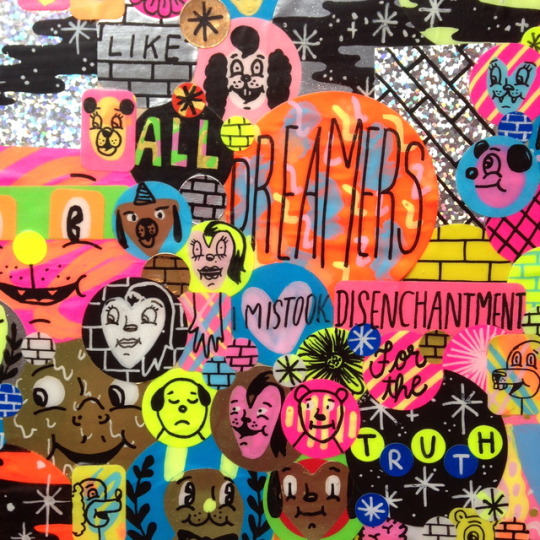


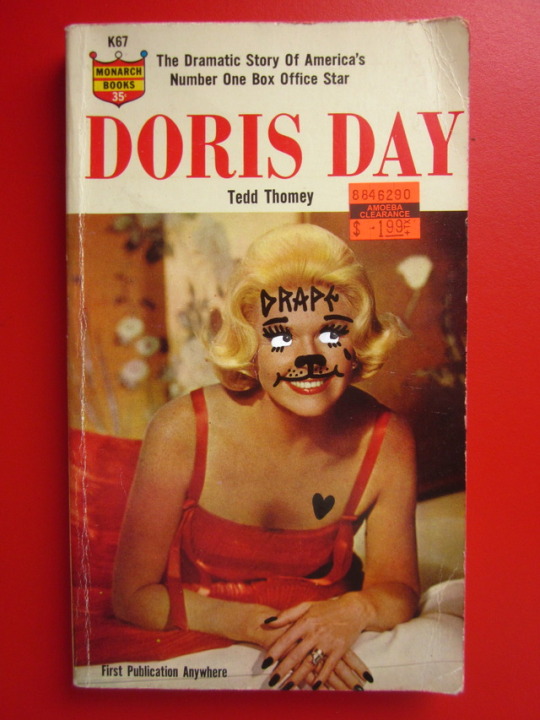
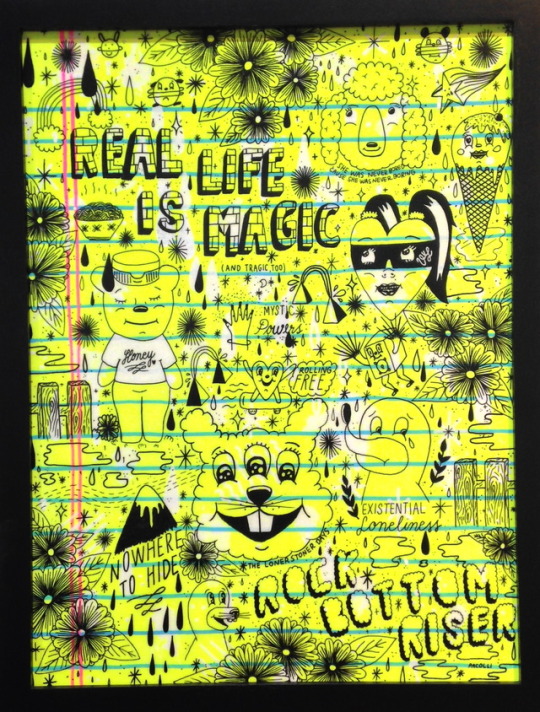
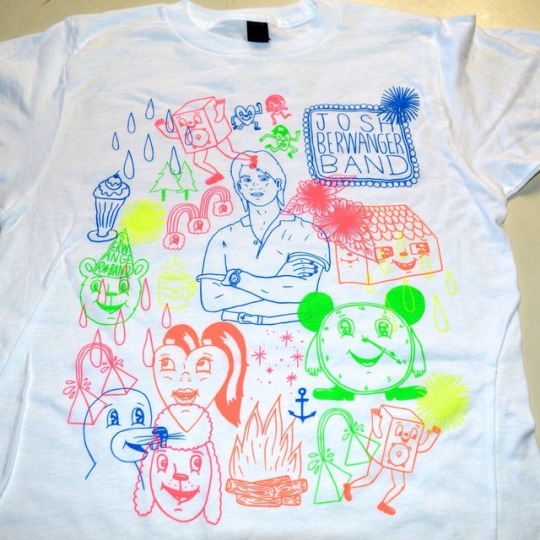
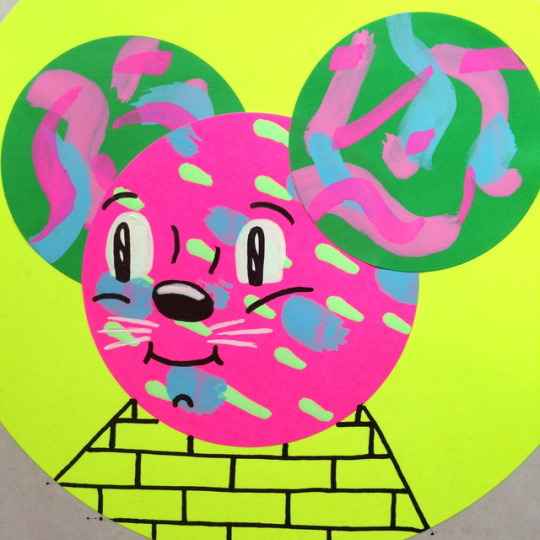


Sketchy Behaviors | PACOLLI (San Francisco,CA)
Working as a producer in MTV Brazil, self taught artist Patricia Colli (Pacolli) started out hand drawing her own calendars and silk screening her own shirts. Making her own way through a mostly male dominated São Paulo art scene, Pacolli's natural creativity, unique eye for color and composition, and ear for the lyrical made her work stand out from the rest. Not only did her colorfully spastic, psychedelic, and angsty work catch our eye, but also her “go-getter” attitude and DIY ethic which permeates in everything she does: from silk screening her own gear, self publishing her zines, managing her online shop, High In The Bay to the recent opening of her new art space–Bendgy in Brazil. We got to chat with this chill artist about her new space Bendgy, her artistic processes, and about the magic of zines.
Photographs courtesy of the artist.
Keep calm, read on!
Introduce yourself My name is Patricia Colli, but people call me Pacolli (it doesn't really have a funny story behind the name, it was just my first email because i wasn't much of a Patty and I had a band with my friend Ronaldo who introduced me to everyone as Pacolli, eventually I stopped fighting it and embraced it, it's like a one name thing like Cher and I like Cher). I'm 35, born in São Paulo (Brazil) and I live in San Francisco, California with my husband and also artist Mildred.
What’s the first thing you remember drawing? How did you first get interested in art and making art? I remember drawing a house in the hills when I was in school and the teacher said that wasn't really good, I went to an italian catholic school in Brazil and they were not a fan of arts. Maybe that's why I started, in a very shy way, to go around it and start drawing all the time. I didn't like school from day one so I started drawing during classes to escape from it. In 7th grade I started drawing the guys that my friends and I had crushes on and passing them during class, we would laugh so much because the drawings were really sketchy and they were all about skipping class to go see them and skipping class to go to concerts, getting fake IDs and being crazy, recklessly teenagers!I always kept something like a sketchbook journal through the years and eventually they started to become zines, and then t-shirts...
What’s your artistic process like? Do you keep a sketchbook or doodle everywhere you go? I do keep a sketchbook with me at all times, and I make a lot of lists of things to draw. I also write down funny/interesting things I heard or read somewhere. I like to take my time to come up with an idea and daydream as much as I can about it before doing it. I like the process of coming up with something and letting it reveal itself as I go on. It's like finding something about yourself there.
How did your life go from drawing as a hobby to drawing as a career? I used to work on MTV Brazil as a producer and I used to make my own calendars with a big drawing on top, my co-workers used to make copies of those to use them too... I thought it was cool that people liked it but I never thought I could do this for a living. A couple years went by and I started screen printing some t-shirts and got invited for a fashion art show in Antwerp (Belgium). It was funny cause I started being asked to participate in art shows and collaborative zines in Europe but never in Brazil, so it was like a fun side gig to me. Eventually I started getting some freelance illustration/t-shirt design gigs/art shows in Brazil and abroad and gave up my tv job, started traveling where my art was taking me and it took me to San Francisco where I am since then.
What are some of the hardest challenges you have faced as an artist and how did you overcome them? It was hard to manage the ups and downs of the job and understand that's how it goes, sometimes you get called to make a bunch of shows and gigs at the same time and sometimes it feels like there's nothing happening for months to end... so I like to make things happen when I have these slower times, experiment different mediums, collaborate with other artists, start a new personal project and be productive. It's important to keep a perspective about those things and to not compare your path to anyone else cause that won't help. I tend to get anxious if I don't have projects lined up, but if there are no opportunities you have to create them yourself.
You have some many various types of characters – heart shaped people, coffee cup personalities to rabbit / cat people. What’s the inspiration behind some of them and do they all sort of have personalities? I guess I see faces everywhere lol, drawing humans is challenging! I make myself laugh sometimes when I'm drawing strange creatures that don't exist doing humane things, it's like it's ok for them to look a bit off because there's nothing to compare them to, you know? I like drawing these characters with human feelings but not in a human form because it's more fun and freeing. Sometimes I make these creatures inspired by my friends, I drew the album cover for my friend's band Polara and we used to drink so much coffee all the time, I thought the best way to go about was to draw a bunch of espresso coffee cups dancing like crazy and dizzy bumper cars cause that's how you feel listening to their music after all that coffee!
It’s always really cool to see you printing your own stuff from shirts to stickers When did you first start silk screening and printing your own things? Has the process evolved for you? I had some friends that screen printed t-shirts and I knew the basic process of doing it, so one day I decided to try one myself and I fell in love with the process and results. It was like playing with stamps all over again (I played with stamps and stickers my whole childhood). Since I was self taught in a way, I didn't know what I was doing...so I started to print things a bit different, not doing the same image over and over. I got a small squeegee and I took my time printing each drawing at once and composing a different story behind each tshirt. I became a screen hoarder!, I never throw them away (unless if they're clogged but I don't let it happen much) and bring them from Brazil - i know, it's crazy! I found my happy place doing these 1/1 prints, it gives me new ideas every time I'm printing, I see new possibilities and experiment without fear, it's very calming and exciting at the same time.
How many zines have you self-published? How did you first start creating your own zine? I self published six zines so far, my intention was to publish at least one every year but I've been slacking on that goal. I had too many sketchbooks full of drawings, my friends would tell me to do something with them and I was always shy and a bit embarrassed about sharing personal things, one of my friends called me out that all I like a lot from other artists are personal and maybe embarrassing things lol.. so yeah I had no excuse anymore! Reading Jeffrey Brown, Vanessa Davis and Esther Pearl Watson really encouraged me to make my own zine at that time! They're work is very personal and it was definitely an inspiration to me!
What is it that you love so much about zine culture? I think it's a very specific kind of subject that you couldn't find anywhere else (before the internet got huge). I started reading music zines about underground indie and punk bands. I think I still see it in the same way, a place to put on specific things you don't find anywhere else. I'm really into checking out the paper and print style, small editions with something handmade or hand drawn on it always get my attention. They're hard to find these days! Fun Chicken (the online shop from Mark Todd and Esther Pearl Watson) have really cool zines and I'm always checking Fudge Factory Comics (Travis Millard's online store) cause there's always cool zines. Well everything they have is amazing!
What have been some of your favorite collaborations? What do you enjoy most about them? I collaborate a lot with my husband, he's been making art and zines for a long time too and every now and then I'll sneak one of our collabs in my zines and vice versa. It's important to have some intimacy with whoever you're collaborating with so you can say what you really think. It's fun to do it and I always learn something from the experience.
Is there a medium you want to try and haven’t? What is currently your favorite medium and why? I got a wood burner from my in-laws last christmas and I haven't tried yet, it's sitting next to me and I'm very excited to try it out.I really like painting with acrylics and india ink on wood panels, there's so many possibilities and room for trial and error.
What are your top 5 artistic influences, past and contemporary? When I saw Dan Clowes comics for the first time, it changed my life! The way he draws and portrays the world was so new but so familiar in a way... he's a huge influence to me because it sparkled my interest in expressing myself through drawing. The same happened when I first saw the art of Clayton Brothers, I realized art could be so cool!! Their paintings and drawings blew my mind, I have never seen anything like that... I remember trying to like mainstream art like Picasso and Mondrian but I truly didn't have an emotional connection to any of these guys, I knew that I felt different when I saw Clayton Brothers in the cover of Juxtapoz in 2004. It was hard to find this kind of art in Brazil, and still is! Keith Haring went to São Paulo in the 80's and painted murals, he was on the tv and I thought he was such a cool guy. My mom gave me a calendar with his drawings on it and I loved it and kept it for years! Same thing happened when I discovered Warhol, his persona was always intriguing to me and it made me like his art even more. I grew up watching and reading Peanuts, so I don't think I can leave Charles Schultz out of this list. I don't separate comics from art, they have the same impact for me. I love his ability to create his own world and still being completely relatable, it's also kind of simple but extremely complex at the same time.
There’s an autobiographical nature and intimacy to a lot of your works because they come from feelings and experiences you’ve had or gone through or thought. Can you talk a little bit of maybe you’ve used some bad experiences in your life to create art from that has been maybe therapeutic? I feel like since my first sketchbooks were sort of journal like, that I've always had this relationship with drawing and letting emotions out... and it's therapeutic, cheaper than therapy as I always say! It's hard for me sometimes to not let it out, so I don't hold back anymore. It's funny cause the more embarrassed I am of something ultra personal that I drew, the more I get people to write me and say they really liked it. My first two zines were miserably sad ("I thought it was a love story" and "Mad for Sadness") I didn't know what to do with myself so I put together a zine with all those feelings. It kept me busy, which is usually a great thing, and a few years later I got emails from these teenage high school girls from San Francisco telling me their teacher showed my zine in class (!!) and they thought it was a good way to survive a heartbreak. I thought it was so sweet! I never thought about it before, you know? Sad things will happen anyway but how you deal with them is up to you.
What common misconception do you think folks might have about being an artist or making art for a living? I think the internet makes things look easier and more glamorous than they really are. I grew up seeing cartoonists drawing and being a bit miserable like Robert Crumb. Have you seen the documentary "Crumb"? I knew it wasn't easy being him and doing what he was doing, maybe it made me have even more respect for his work. He never tried to portray any glamour about being an artist and I think it's more like the real thing. These days people don't care for struggle, they seem to always want the easy way and that's not how art goes most of the time so I think it's funny and sad in a way. People rip off your work and forget you're a human too, trying to survive in this messy world.
What do you do to overcome those days when nothing you’re making is turning out right? What do you like to do in your off time? I like to read books when I don't know what to do with myself, it helps me to shift the focus and get into something else than my own drama. It helps me with anxiety and always sparks new ideas. Going to concerts and playing drums are my other escape tools for living a better life, music is magic... the power of live music is amazing, going to concerts is one of my favorite things to do!
Tell us about your recent trip to visit Brazil. When you lived there, you used to do some events called Bendgy. Can you tell us how they came about and how your recent visit went? I lived in São Paulo for 28 years, it's a huge city with a lot of cultural things happening all the time, the pace of the city is maddening and it's hard to keep focus sometimes, but regardlessly it's where i'm from and I love it! I started throwing an art party/concerts in my apartment when I started to make tshirts around 2006-2007. It was a very low profile thing, just for friends and just for fun... i didn't wanted to reach out to places that already existed and try to sell my art because it was weird... so I started something unpretentious to do what I was doing and that's Bendgy!It was an art party with a concert Saturdays afternoon in my apartment, i would sell beers, vegan sandwiches and tshirts. A lot of my friends are musicians so I wanted to have a band and we would support each other, it started getting bigger and I was scared of the risk of being kicked out of my apartment for the loud noise and amount of people coming in...I threw a few Bendgys at my friends places and eventually my dad moved out of his house and it was empty for a while, I started throwing bigger concerts there and it was so much fun!
How is Bendgy now? I just came back from SP and it was a long process but now Bendgy is a real art space, I got a great staff and we open every Saturday! We're having an international art show called "Hit the ground running" with the art of Albert Reyes, Jason Vivona, Jeff Roysdon, Mats!?, Mildred, Michael Hsiung (you!) and myself! In addition to the art show, there's a zine/print/tshirt/stickers shop and we have more affordable things from all the artists in the show and from other great artists from the US, Argentina and Brazil. I'm stoked that it turned out the way it did! It was so much hard work putting it together, I thought I was going crazy.. i felt like Donal Duck, but it was worth it!I book every band and make almost every flyer for it, so it's like I'm there but I'm not.
During your time living in São Paulo, Brasil, what was the art scene like? It was most like an all boys club to be honest. Graffiti and pixação (São Paulo style of tagging) were the underground art that I liked but always made by guys, some really talented ones too! Like, Os Gemeos still blow my mind and were always a reference for me to what brazilian art is, even though they are more respected as artists outside Brazil. I think they're a good example, for some reason Brazil doesn't cherish their own artists until someone else says it's good. It needs a foreign stamp of approval that always made me bored about it because there's so many great artists there!
Who are some artists in Brazil you admire? and why? I love Stephan Doitschinoff's art, he creates his own world and he is very focused on being true to who he is. His work has always been an inspiration to me on how to do things, if there's not a scene for what you're doing you create the scene!
Throw a zine fest or an art party, and make no excuses for not doing things. People tend to complain there's not enough opportunities there, but i feel like it's also in our own hands to make things happen and not just wait for someone to invite you to be part of something. Jaca is another extremely talented artist living in São Paulo, he is super humble and not really into posting his art online. He doesn't need no approval or applause and I love that! He looks inside himself and his works reveal that to us, it's very inspiring! He will have a solo show at Bendgy in July and I can't wait to see what he's going to do.
When did you start your online store High in the Bay? The products on there are all hand made by you in SF? What’s it like keeping your own shop? I started High in the Bay with my husband, Mildred, when I moved to SF in 2010 to make it up for the fact that I couldn't do a Bendgy here (i would have been evicted right away) so we did an online store.We do carry zines from other artists that we like and sometimes we make collaborative zine packs so people get to know other things than our own work, they get to see what we like! I brought some books, prints and zines from an amazing artist from Argentina called Tomás Spicolli, his work has been a big influence to me so I was very happy to have his art at Bendgy and soon at High in the Bay. It's important to learn to manage something even if it's an online shop, so then you get the grip of it and can do things better in the future, I used to work at Needles and Pens and I learned a lot from them on how to do things, it really helped me when I was doing Bendgy and High in the Bay.
You done a lot of cool art for bands! What has been your favorite collaboration? Thanks, man! I have to say I've been lucky to have worked with cool people, like I told before the Polara album cover was a cool one, it's coming out sometime this year in Brazil. All the bands were really cool to me and we became friends, I did a tshirt design for Josh Berwanger Band a few years ago, it had a funny request "draw Patrick Swayze in Road House"! And there was another album cover i did for Swivs that was so much fun to do, his music is so good!!
Give us your top 5 bands or tunes while creating? How does music influence your art? I'm very into the new Afghan Whigs album called "In Spades", and all their music really. It's one of my favorite bands ever, I have drawn so many of their lyrics consciously and unconsciously!I just came back from a concert last night in Oakland from another favorite of mine, The Magnetic Fields. They're great and i came back from Brazil earlier just to see them, love everything that Stephin Merritt does, forever and ever.I'm very into the same bands for the longest time, I love the Ramones, Pulp, Os Mutantes, Cypress Hill, Tupac, Jonathan Richman, Spaceman 3... my music taste is all over the place!Music is a major influence to me, since I was a kid my best friend was not my pen but my radio.
What are your favorite Vans? how would you describe your personal style?Ok, there was a limited edition Lo Pros Saddle shoes that was SO cool! I have a photo of me wearing it, cause i wore it all the time! I'm a Hi Top girl, black and white or just white ones, love those!
What’s the best and worse advice you’ve gotten about art? Best advice is to work hard and be true to yourself, sounds cliche but it's the truth.Worse advice is when people told me I had to go to art school, it might work for some people but it wasn't for me...
What’s on the horizon for the rest of 2017? There's one big project that i'm super excited about but can't talk about it yet... And there will be lots and lots of cool art and live music happening at Bendgy!
Follow Pacolli Website: http://www.pacollipacolli.com/ Instagram: www.instagram.com/pacollionline Shop:https://highinthebay.bigcartel.com Bendgy: www.instagram.com/bendgysp
75 notes
·
View notes
Text
The Collegian is Back in Print

Collegian editor Hazel Lim and staff Sze Xin Khoo (L-R) working on the page layout of the print copy of The Collegian in the studio. (Photo courtesy of Charis Lee / For the Collegian)

UIU archivist Janette Garcia explains the history of The Collegian. Garcia refers to previous issues of The Collegian to check the history of the school. (Photo by Hazel Lim / Collegian Staff)
On Dec. 11, 250 printed copies of The Collegian were distributed to students, staff and faculty members. The Fall 2018 newsroom took up the print project to bring it back in print since going completely digital in 2010. The newspaper will publish its next print copy by the end of Spring 2019.
The Fall 2018 newsroom consists of editor Hazel Lim, and staff members Jack Beulke, Chee Chung Ho, Khoo Sze Xin, Jessica Kron, Ling Sze Hwa and Erin McIndoo.
“Pushing for the print copy has been something I wanted to do since I got this job four-plus years ago,” Collegian adviser Dr. Matthew Foy said. “As soon as I found out from Elissa Wenthe, my department chair, that it was not only possible but something we were prioritizing, it became a matter of whether the Collegian staff wanted to do it.”
The first issue came out of the Communication department’s budget. However, it was not until midway throughout Fall Session II when the Collegian received the full thumbs-up from the department.
“I can't praise this year's staff enough,” Foy said. “They were willing to jump onto the print project in relatively short order. I told them, ‘We can do this if you're ready.’ They took on a new project and all the accompanying unknowns and challenges, and got it done fast and well.”
The Collegian editor Hazel Lim joined the newsroom in January 2018.
“Bringing The Collegian back in print is definitely the highlight of my university life,” Lim said. “I’ll always remember the moment I first held the pages in my hands. It’s a success, thanks to my amazing team and of course, Dr. Foy, who has always been a great guidance to us. We couldn’t ask for a better adviser.”
The UIU Collegian newspaper was first established in 1883. It is the oldest continuously running campus newspaper west of the Mississippi. Back issues of The Collegian have been digitized and are available online at http://uiucollegian.advantage-preservation.com.
The last print version was a 4-page copy published on Oct. 1st, 2010. The newsroom had two editors, one co-editor and four staff members, led by faculty adviser Katrina Mcneely Farren. On the second page of the 2010 edition, a column introduced the transition of The Collegian to becoming an online news site. It read: “The Collegian is now online! Starting Friday, October 8, the site will be live and ready for visitors.”
According to university archivist Janette Garcia, the campus newspaper tried to maintain a weekly cycle in the past.
“Returning in print is definitely a step forward,” Garcia said. “In terms of historical material, regardless of the version or software, paper can be hundreds of years old, and you will still be able to read it. It doesn’t require any special equipment.”
The words of the first The Collegian issue are clearly readable up to this date, 136 years after print. All printed issues of The Collegian can be found at the Henderson-Wilder library on Fayette campus.
Foy explains that printing a physical paper is vital for a college publication to appear legitimate.
“Even in this age in which we get our news online, there's something powerful in being able to point to a physical, tangible paper,” Foy said. “It feels important even if it’s ultimately destined for the recycling bin, and I think that's as true for The Collegian as it’s for the New York Times,” Foy said.
The Collegian intends to be a bi-weekly newspaper. The newspaper will publish its next print copy by the end of Spring 2019.
The Collegian’s mission statement is: “To promote community service and to provide students, staff, faculty, family, friends and community members with the latest news on and around the Upper Iowa campus.”
“When I want to check the history of the school, the first place I go to is either The Collegian or the year books,” Garcia said.
Foy said, “I'll always be a newspaper guy, or at least a print media guy. I want our students to use The Collegian as a place to document what's happening in their school and community, and to weigh in on matters of importance to them. I can't imagine being passive enough to not want that opportunity.”
“I was excited to finally distribute the paper to the students,” newsroom staff Jessica Kron said. “I love seeing the team’s hard work and being able to actually hold it in our hands was really cool. I’m proud of everyone working as a team to create a really great product.”
Kron, who had had no experience laying out a newspaper before, learned how to use Adobe InDesign to layout the print copy of the latest issue.
Newsroom expands physically and virtually
In January, the Collegian has just introduced its first work study position. The team hopes to have more staff members to have a fully functional news team.
“I wish I had greater numbers, but I'm not only happy about the print paper, but we've also started publishing stories from our online students,” Foy said. “This is a whole other world and a whole other perspective.”
Returning as a physical paper does not stop the newsroom staff from updating current UIU news on The Collegian Tumblr page at http://theuiucollegian.tumblr.com.
“I'd love to see us grow toward a fully staffed newsroom with multiple editors and a bright, vibrant position on campus,” Foy said. “I can't and won't stop trying to recruit folks until The Collegian is something people come to UIU wanting to be involved with.”
According to Foy, recruitment is challenging because students are “loaded in terms sports, jobs and other commitments.” He explains that international students, additionally, are adjusting to a whole new culture and may be weary of another activity, especially one that requires writing.
For those who are yet to commit joining the team, story and photo submissions are open to all students, staff and faculty members.
“My challenge is to convince prospective contributors that being part of the Collegian isn't just another thing to write,” Foy said. “One of my favorite aspects of my profession is interacting with someone who has an idea and helping them make it happen, or make it better. When someone has an idea for a story, or wants to try a different way of covering a familiar story, there's true joy in it for me to offer whatever light I have to support that idea.”
“The Collegian has given me the opportunity to learn much more than any class can teach,” Lim said. “From joining the newsroom as a reporter, and now becoming the editor, it has truly been a life-changing experience for me. The hands-on journalism experience is invaluable. I can’t tell you how proud I am to be a part of The Collegian.”
0 notes